How to Use ChatGPT to Get 10X Better Answers
This guide will show you how to use ChatGPT the right way. Brand new to using it? I’ll help you skip the rookie mistakes that leave most beginners frustrated. Tried it before and had an average experience? No problem....
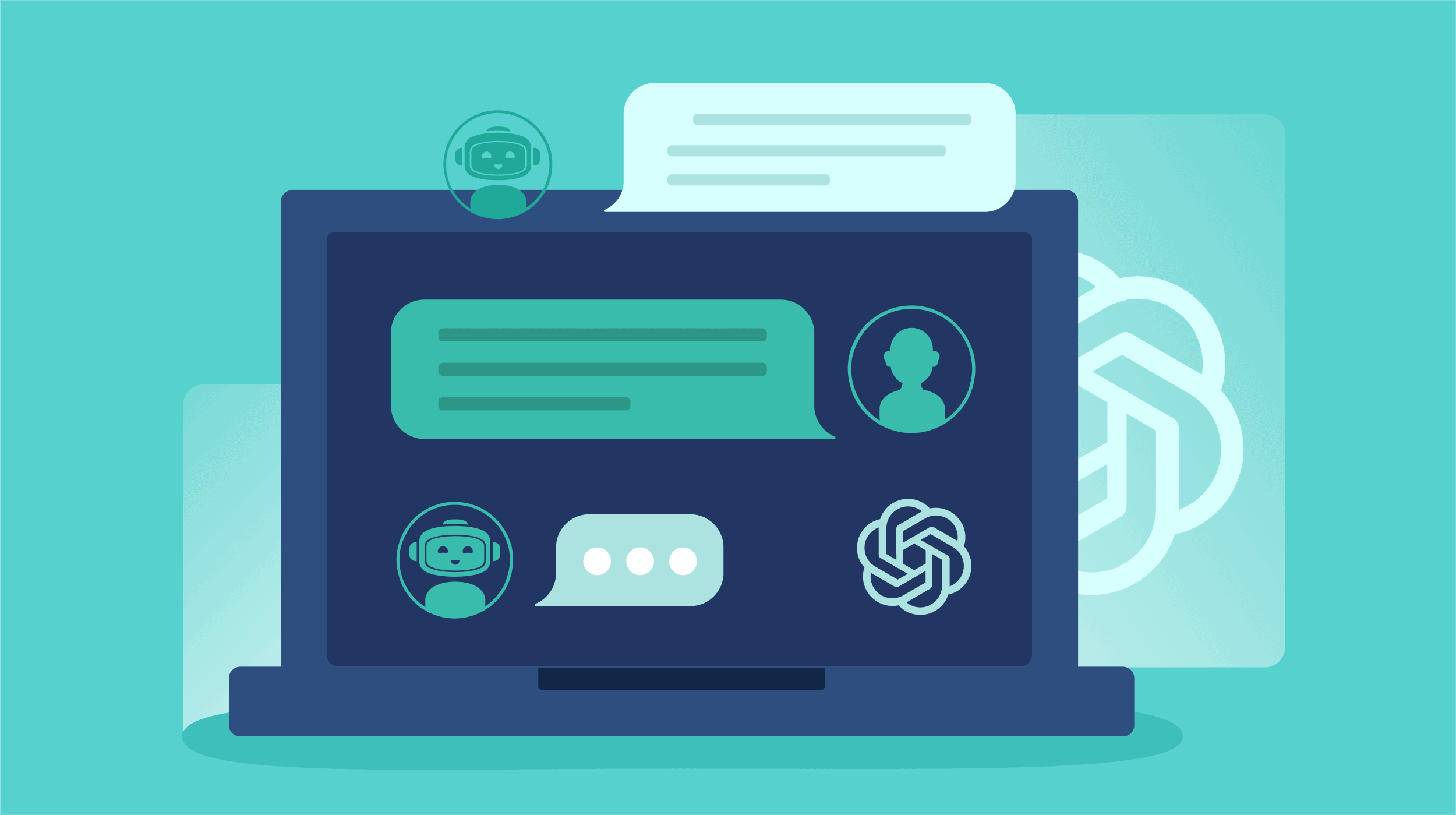
This guide will show you how to use ChatGPT the right way.
Brand new to using it?
I’ll help you skip the rookie mistakes that leave most beginners frustrated.
Tried it before and had an average experience?
No problem. You’ll learn how to refine your approach to get useful, high-quality responses (finally).
Because here’s the thing:
ChatGPT IS a powerful tool. But only if you know how to use it effectively.
Let’s make that happen.
What is ChatGPT (And What Can It Do)?
ChatGPT is an AI assistant that answers your questions like a human would.
It can also generate ideas and assist with writing, problem-solving, and research tasks.
How does it do this?
It analyzes lots of books, web pages, and conversations — this is its training data.
Then, it predicts the most relevant response.
Think of it as a brilliant researcher who’s read millions of books and the entire internet.
It can recall any facts and instantly connect ideas to generate the most relevant answer.
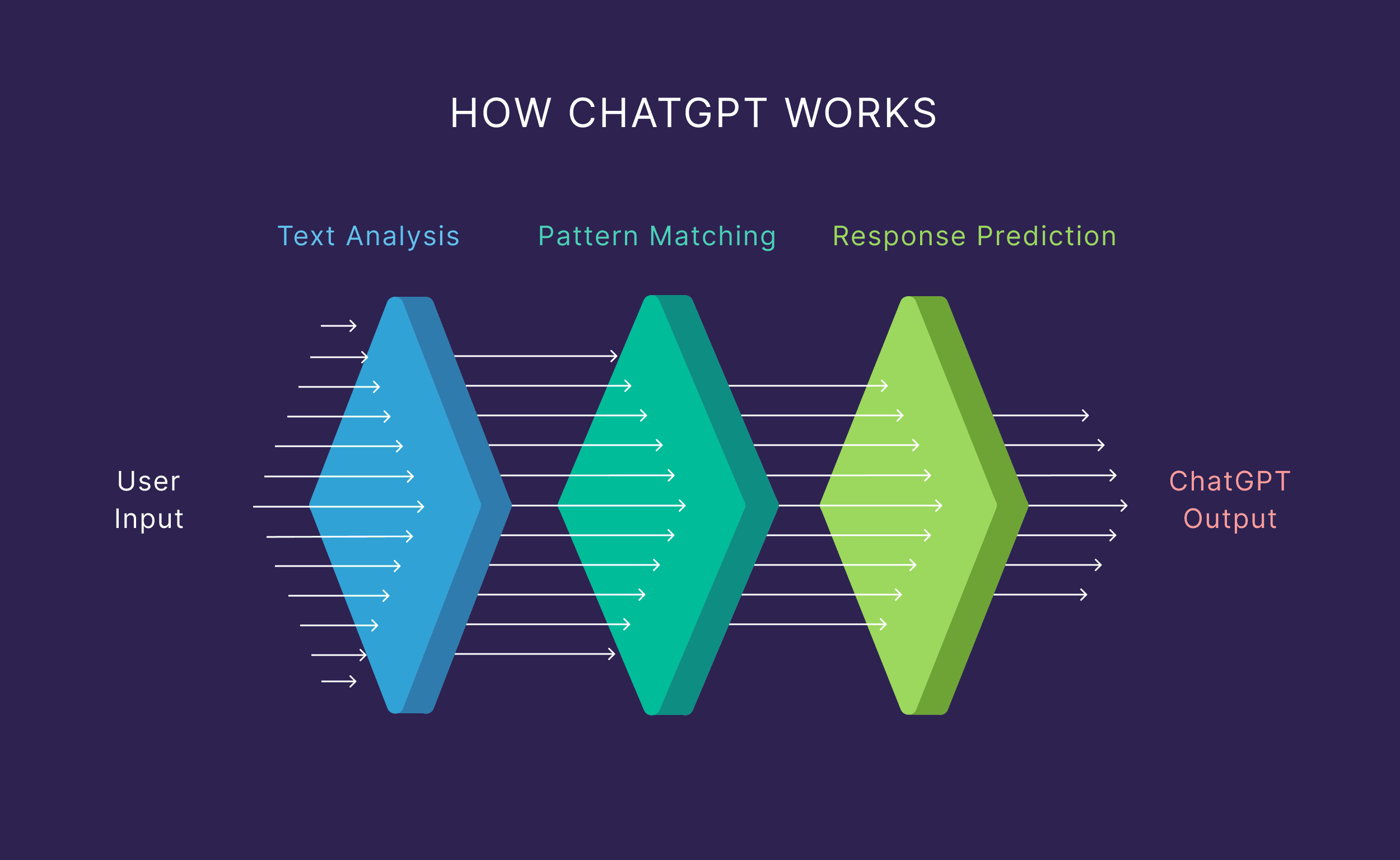
(We talk more about how generative AI works in this article.)
So, what can ChatGPT do?
A surprising number of things.
It can help you:
Brainstorm blog post topics Plan your content strategy Debug code snippets Translate marketing copy into multiple languages Explain blood test results in simple termsPlus, depending on the model you’re using (more on that below), it can also:
Generate images using DALL·E:
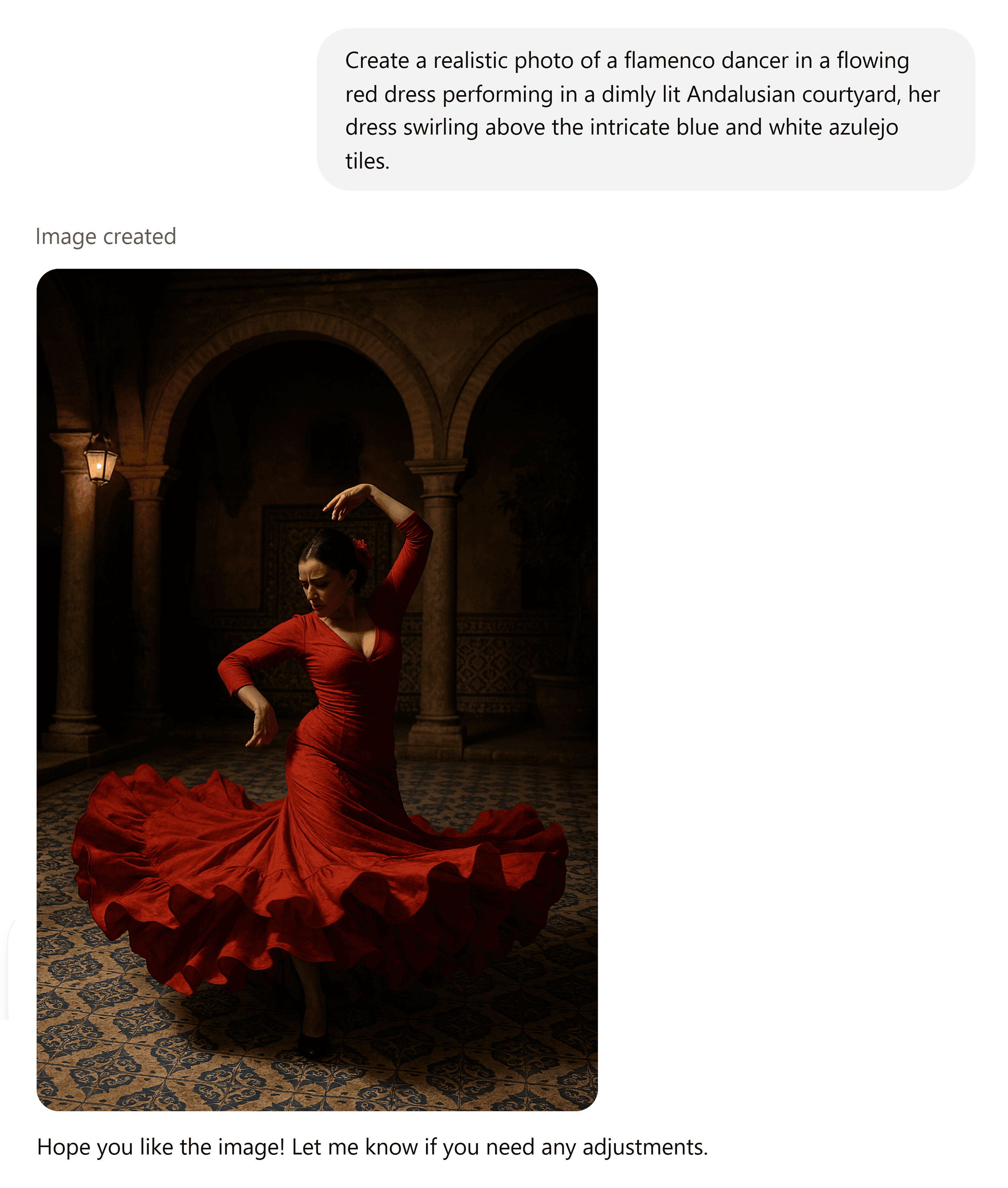
And handle voice interactions.
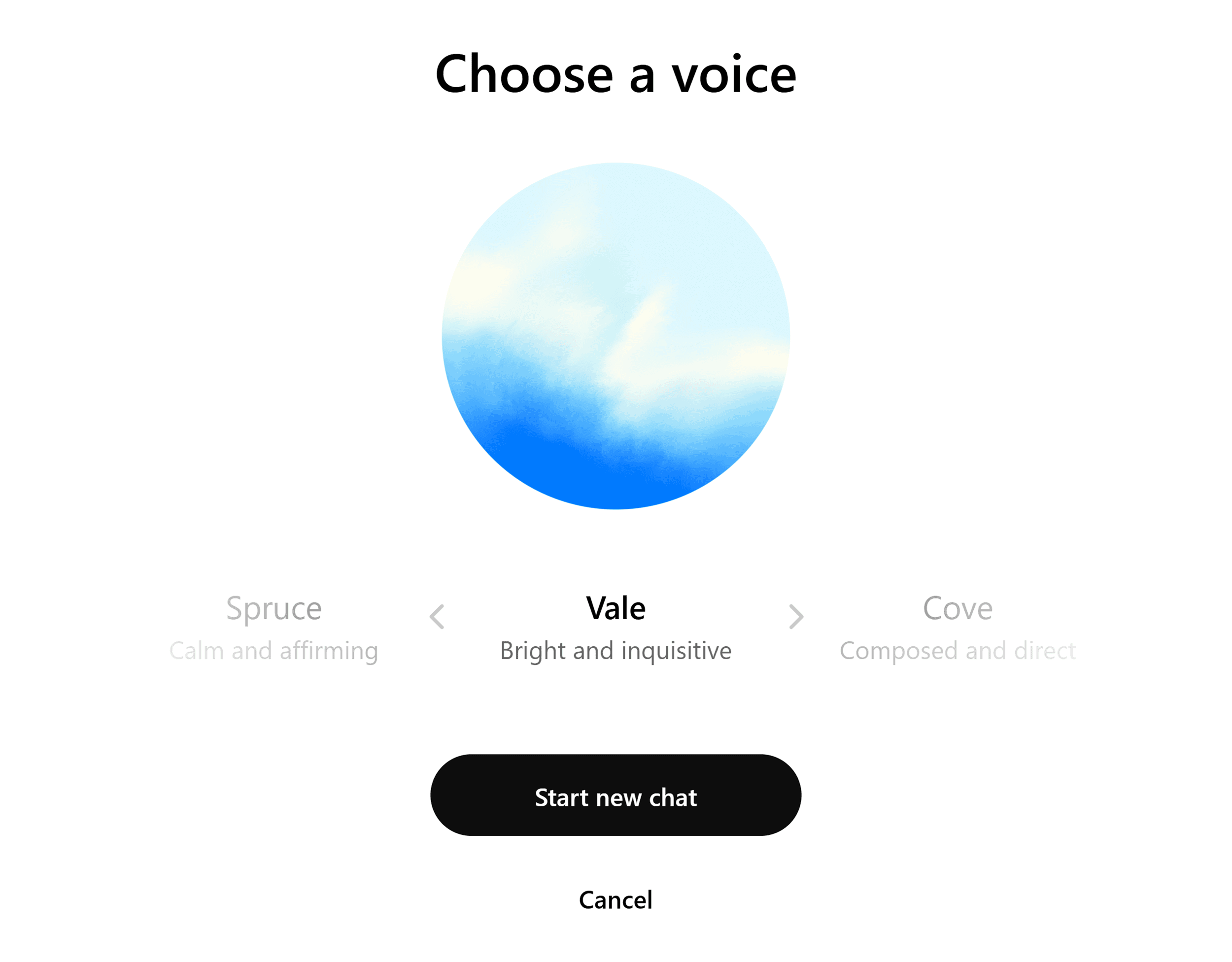
ChatGPT Models
OpenAI (the company behind ChatGPT) regularly updates ChatGPT with new training data.
That’s why there are different ChatGPT models.
Each one is optimized for different tasks.
| GPT-4.5 | Advanced model for reasoning and creativity. Better pattern recognition. |
| GPT-4o | General and professional use. Also good for coding & deep analysis. Multimodal. |
| GPT-4o mini | Everyday tasks. Gives responses faster but lacks advanced tools. |
| o3-mini | Coding and advanced reasoning, great for problem-solving & logic tasks |
| o1 & o1-mini | Complex problem-solving but lacks memory and search |
| GPT-4o with Scheduled Tasks (BETA) | AI automation |
ChatGPT Limitations
It’s no secret.
ChatGPT makes things up sometimes (aka a “hallucination).
It’s not really thinking for itself.
Instead, it predicts words based on patterns in its training data.
And sometimes, those predictions are completely wrong.
For example, Łukasz Białozor, an AI consultant, asked:
Instead of correcting the prompt, ChatGPT named one person—even though 706 people survived.

Bias is another issue.
AI models like ChatGPT reflect societal biases that exist in their training data. Here’s a simple way to see this in action:
Ask it to draw a nurse. You’ll likely get a woman.
Now, ask it to draw a CEO. You’ll probably see a man.
Here’s what I got:

This gender bias isn’t just limited to images. ChatGPT can perpetuate stereotypes and biases around:
Gender roles and professions Cultural perspectives Socioeconomic assumptions Historical narratives Geographic representationFor example, when asked about “traditional family values” or “successful business practices,” ChatGPT might default to Western, male-dominated perspectives without acknowledging other viewpoints.
What does this mean for you?
Always cross-reference important facts from multiple sources Be aware that ChatGPT’s responses may reflect societal biases Ask follow-up questions to get different perspectives Use ChatGPT as a starting point, not the final authority Consider whose viewpoints might be missing from its responsesHow to Use ChatGPT: Step-by-Step Beginners Guide
If you’re new to ChatGPT, getting started is easy.
You’ll be using it like a pro in just a few steps.
Step 1: Choose the Right ChatGPT Account Type
There are three ways to access ChatGPT, depending on what you need.
Guest Access
You can try ChatGPT right away with “Guest Access.” No need to sign up.
Just go to chatgpt.com, and start chatting.
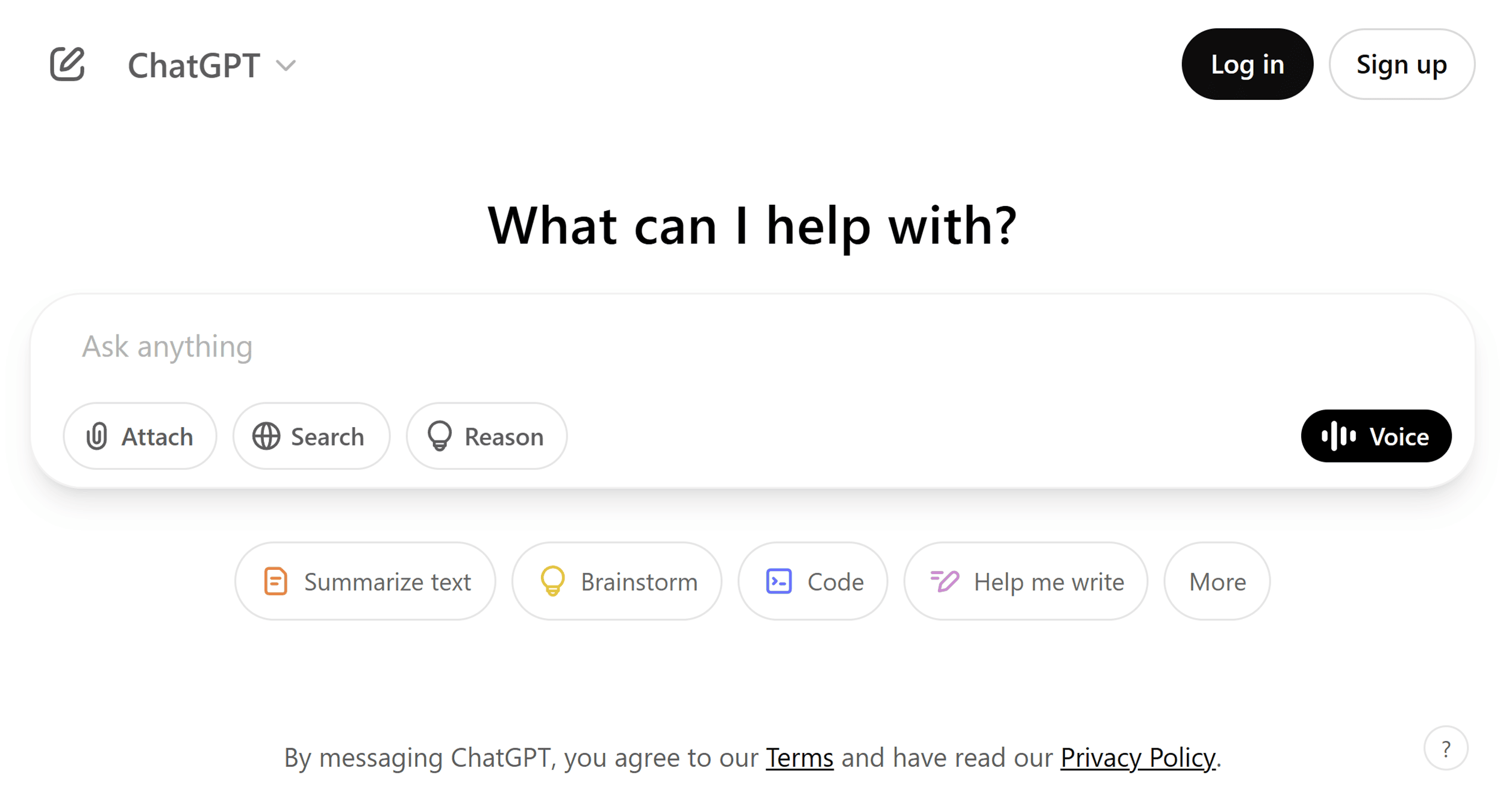
It lets you ask questions and even search the web.
But your conversations won’t be saved.
Once you close the page, everything disappears.
If you’re testing it out, “Guest Access” is fine.
But if you want ChatGPT to act like a real assistant, you’ll need an account.
Free Account
A free account gives you more features and better answers.
For example, the “Reason” feature helps it think before answering, so you get sharper, more accurate responses.

You can also upload files like PDFs and spreadsheets, making it easy to work with large documents.

Another benefit?
Your chat history saves.
You can return to past conversations and pick up where you left off.
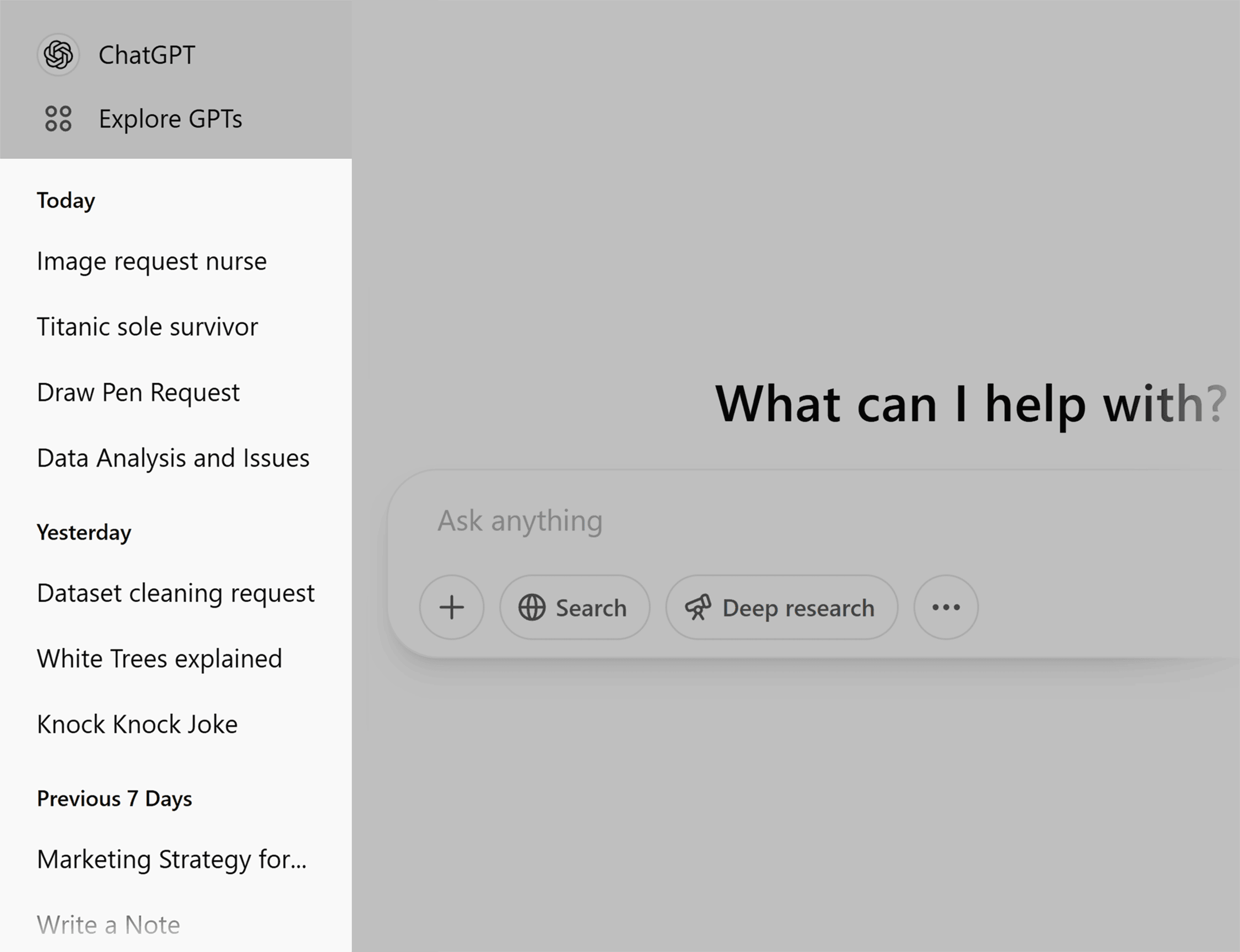
Another big benefit is that you can customize ChatGPT responses.
(More on that below.)
So, every time it responds to your questions, it answers in a way that matches your style.
How to Sign Up for Free
Go to chatgpt.com. Click “Sign up.”
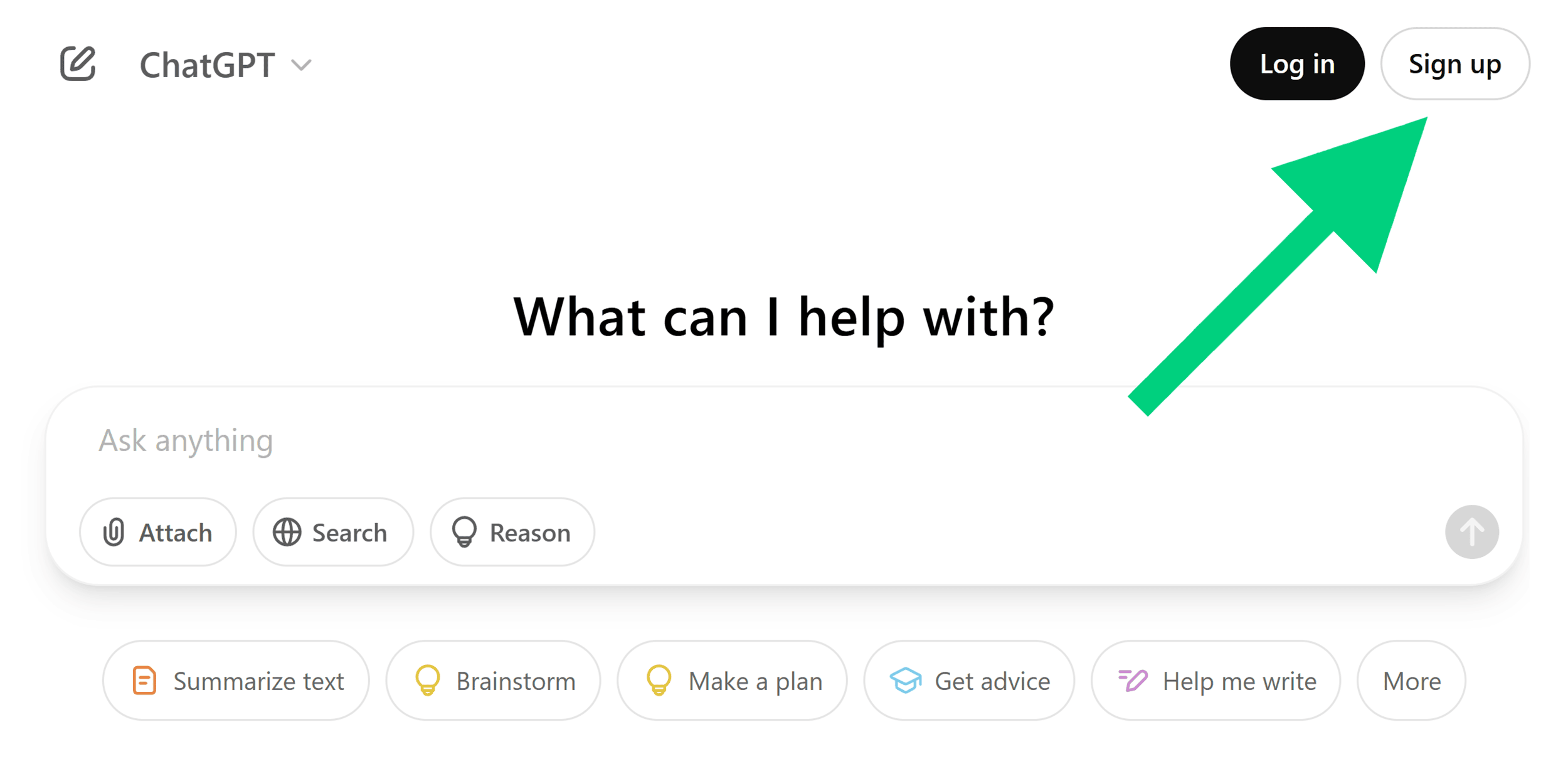
Enter a valid email address or sign in using Google, Microsoft, or Apple.
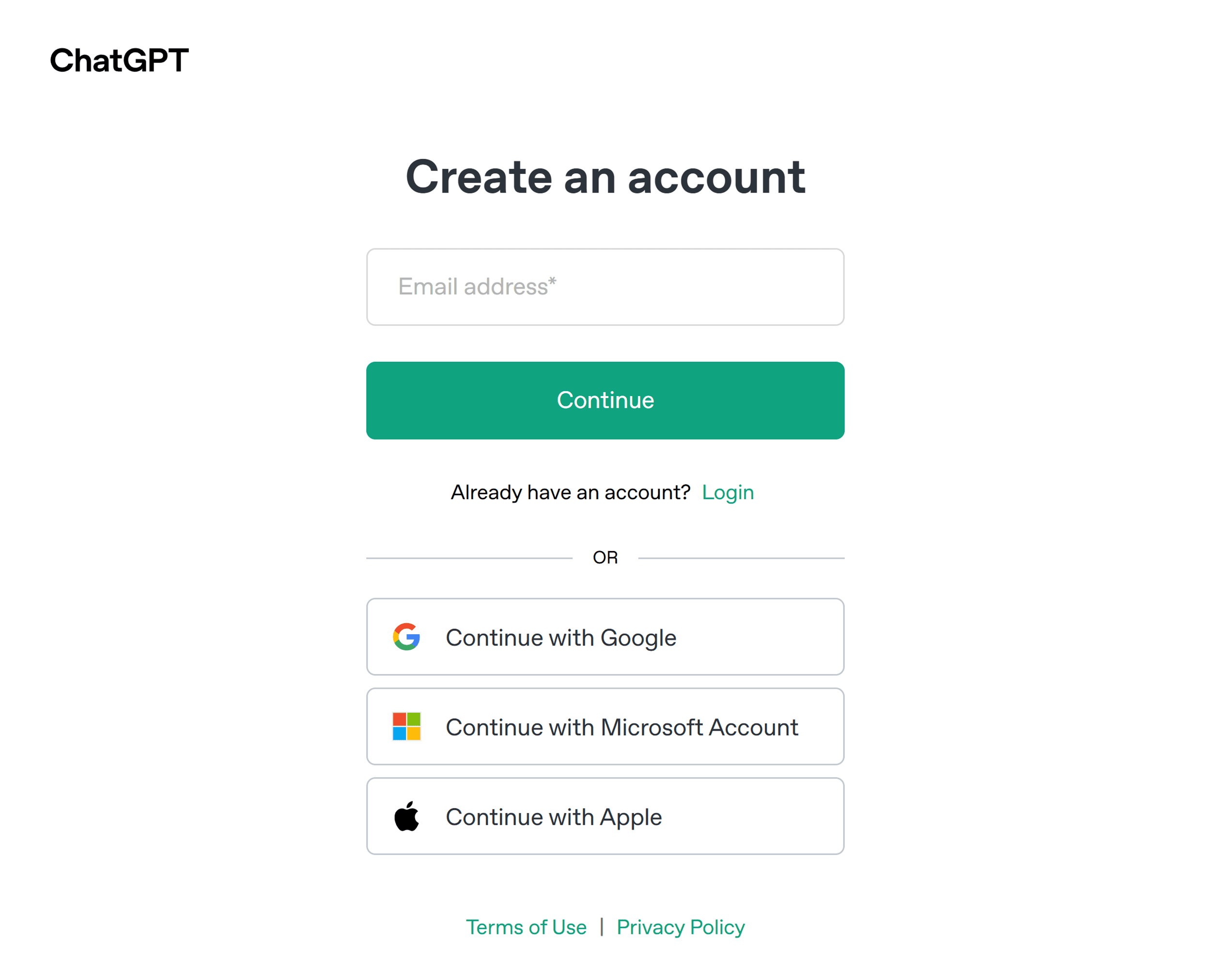
Create a password.
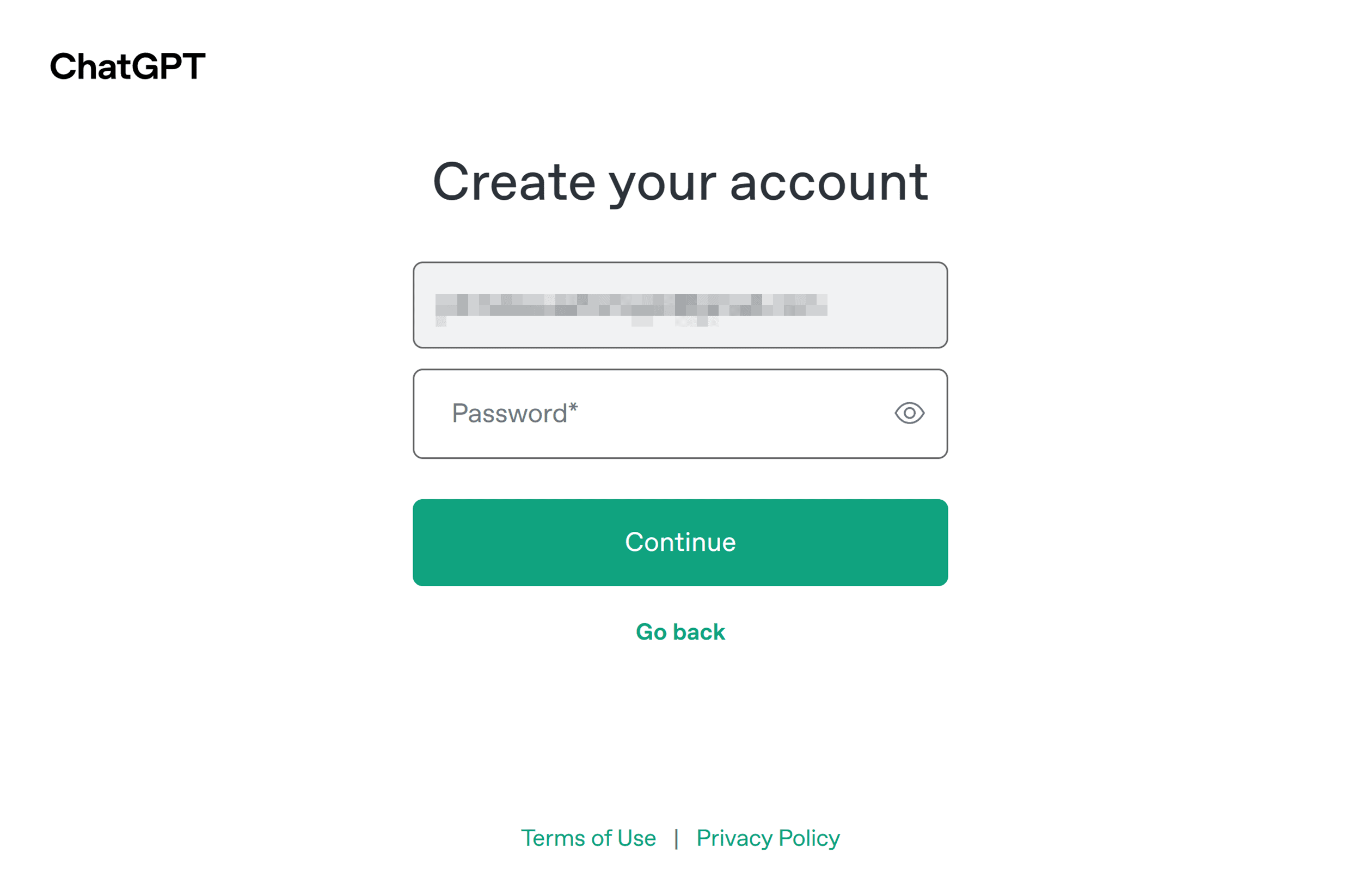
Then, add your name and birthday (both are required).
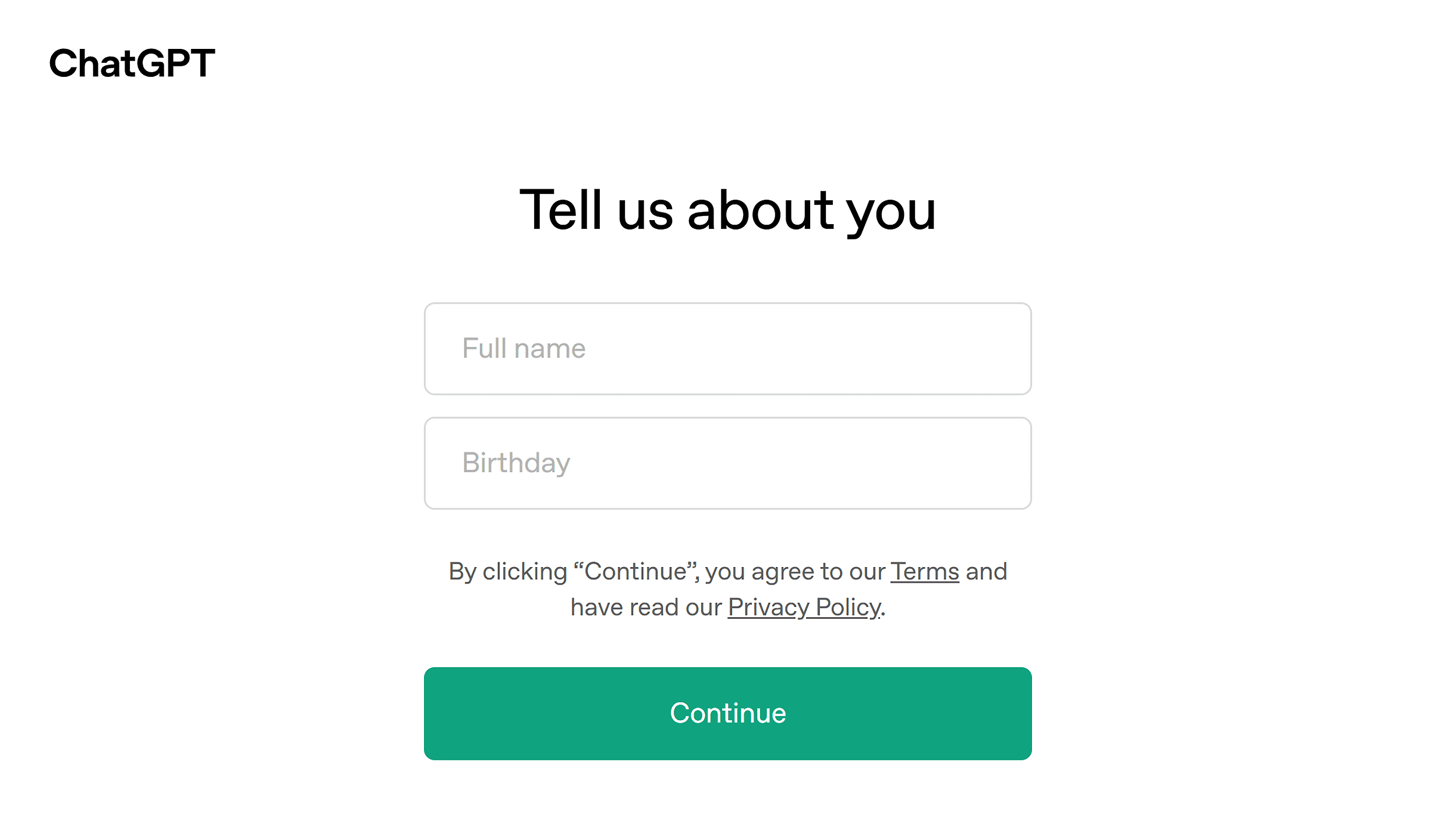
And finally, choose if you want ChatGPT to remember your conversations (you can change this later).
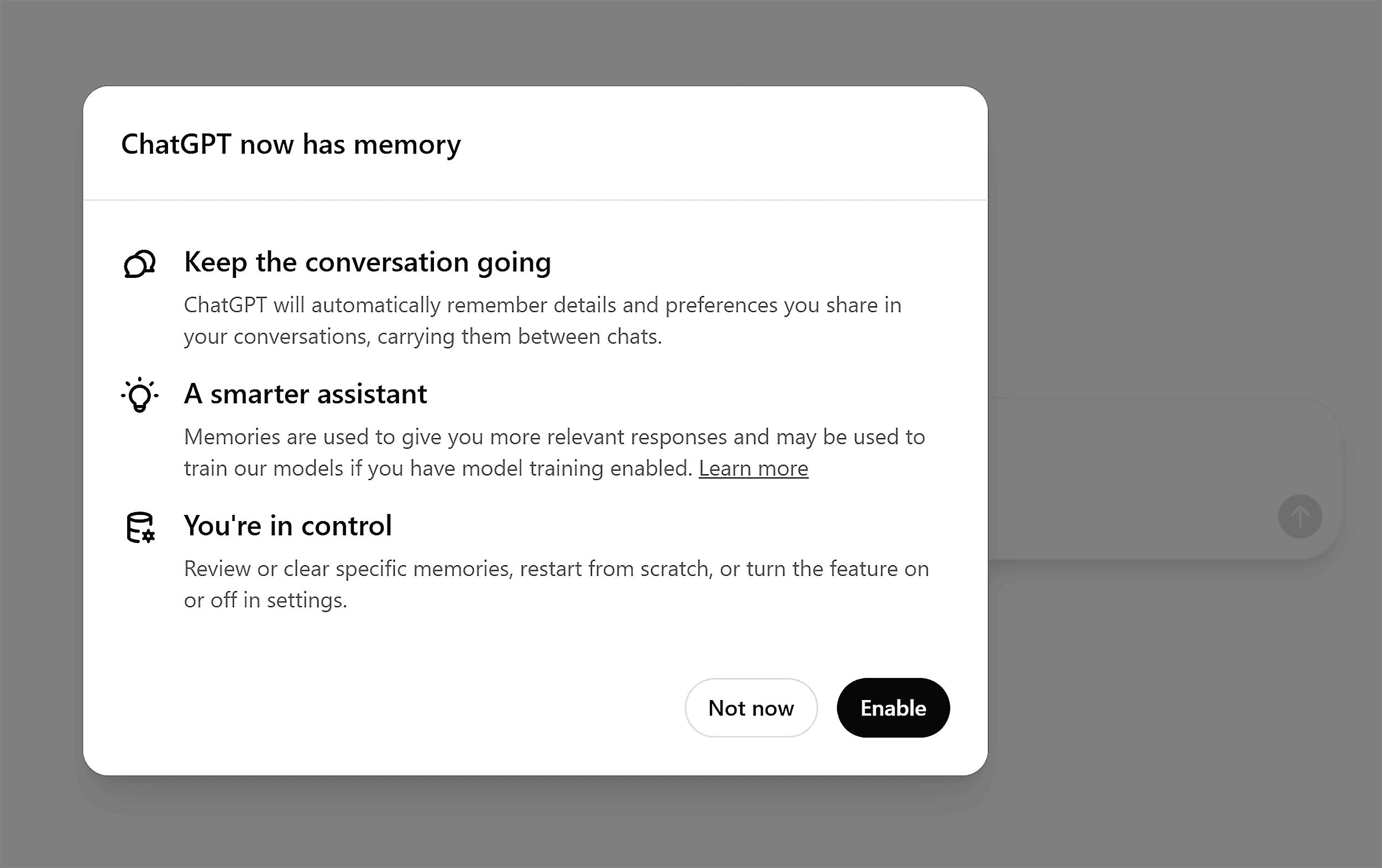
That’s it. You’re set.
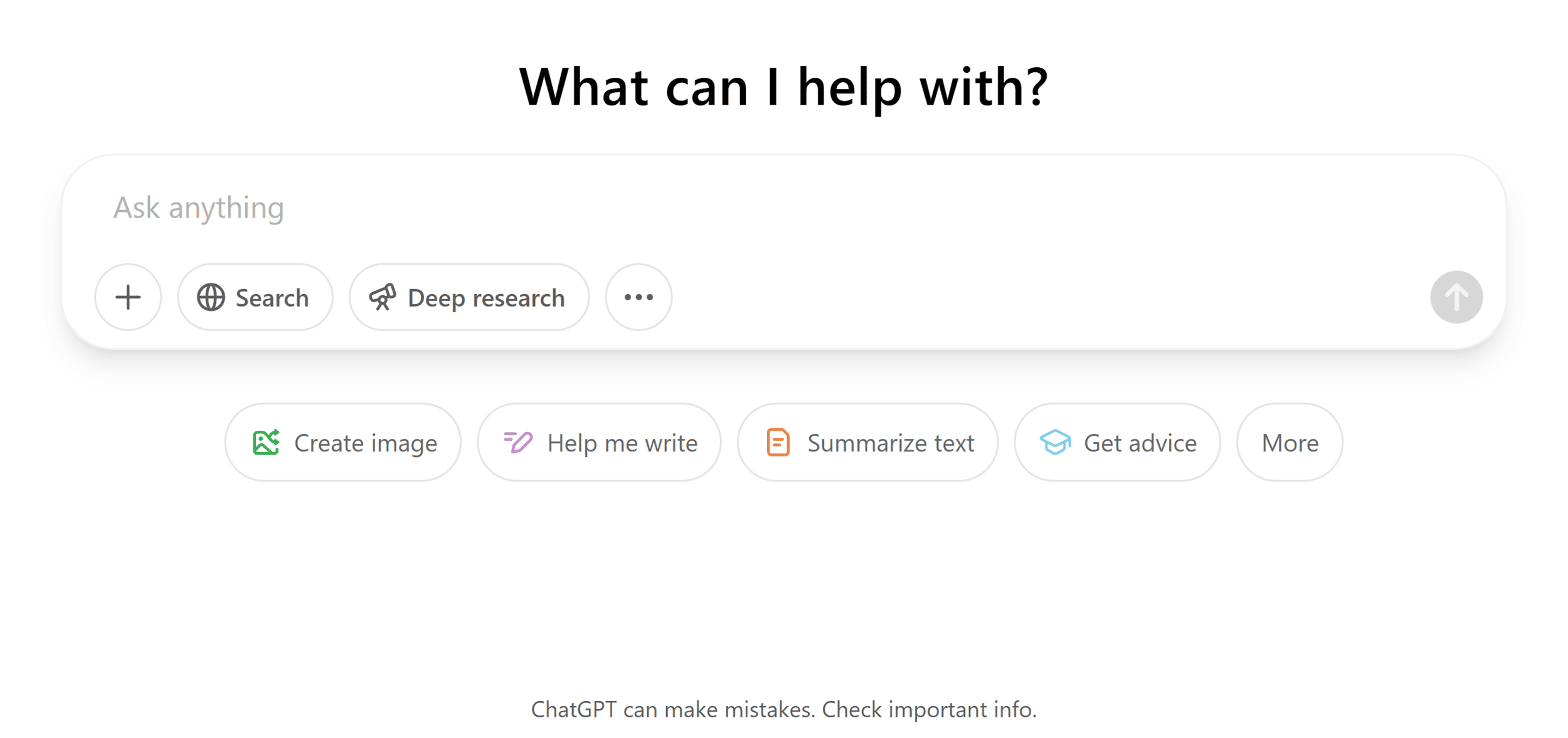
Paid Subscription
If you use ChatGPT a lot, consider upgrading to ChatGPT Plus for $20/month.
This gives you access to all ChatGPT models, including the latest and most advanced versions.
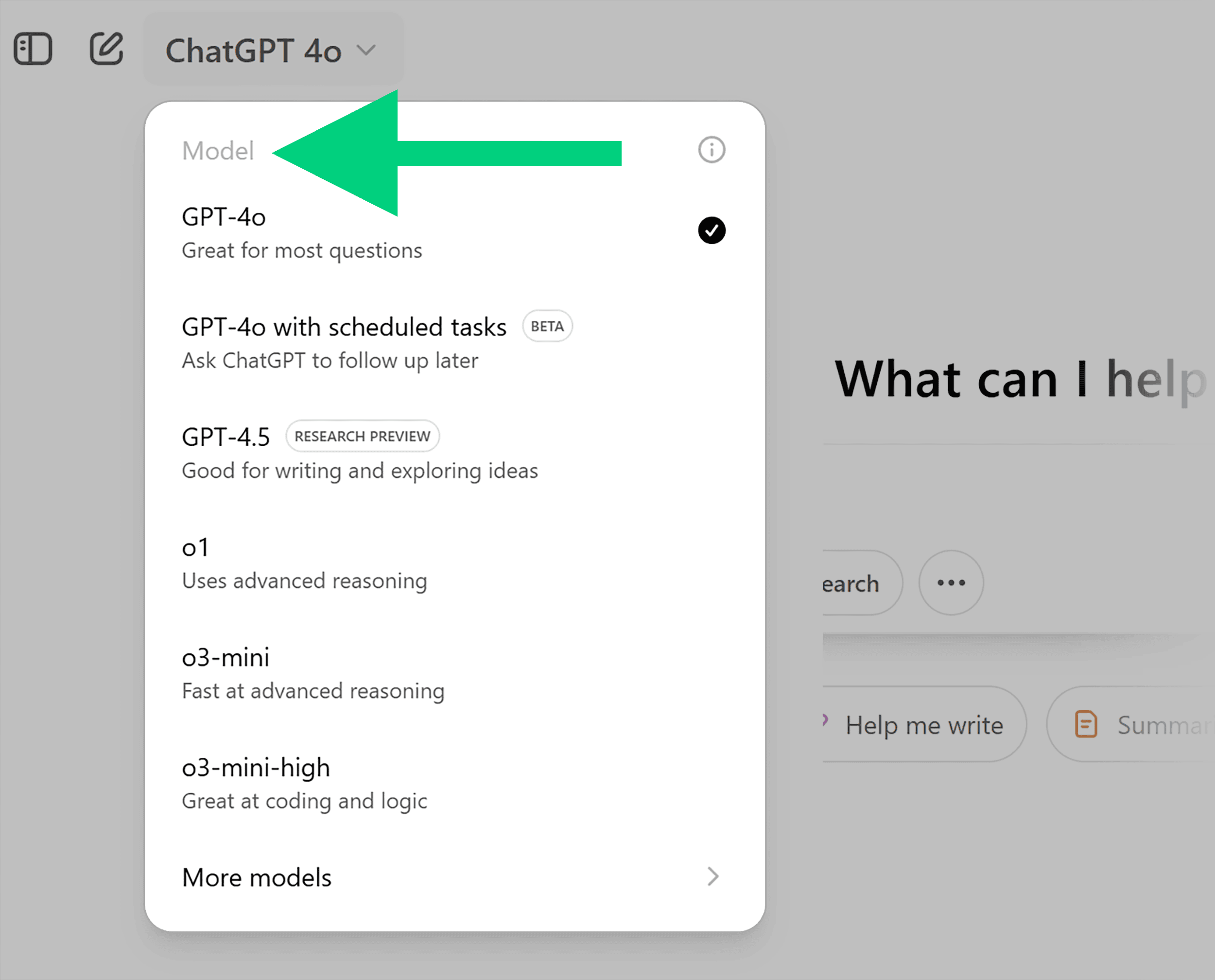
You even get 10 “Deep Research” searches per month.
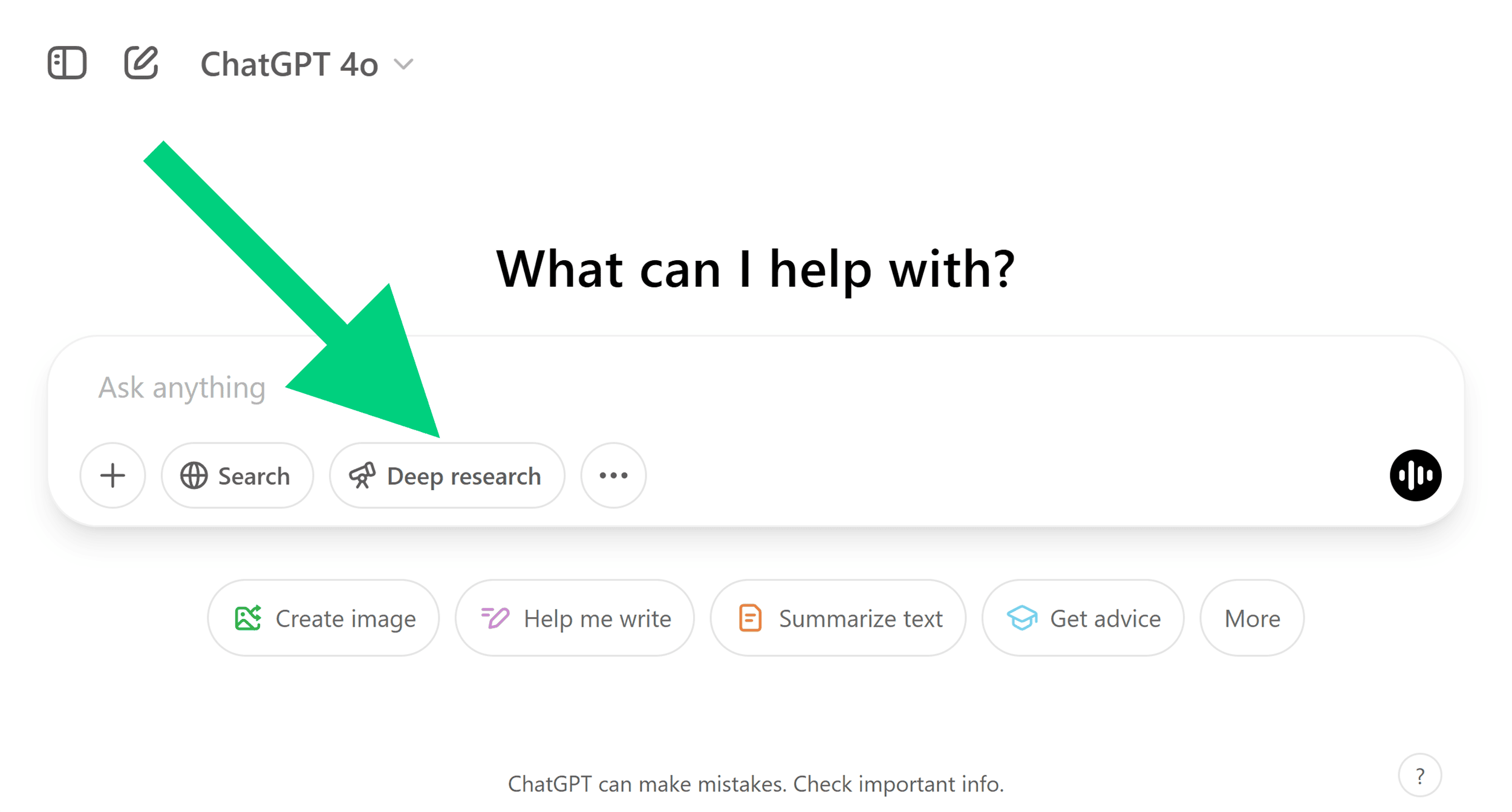
This allows ChatGPT to search multiple web sources in one query.
You give it one prompt, and it’ll independently search websites, read research papers, compare products, and more.
It’s great when you need to research and visit many websites, such as when you’re comparing products before you buy.
Or when you need to go through scientific journals for research.
Oh, and another benefit?
Faster responses, even during peak hours (7 AM to 5 PM ET).
While free users wait, you keep chatting without interruptions.
Step 2: Tweak the Default Settings
ChatGPT works great out of the box, but a few tweaks can make it even better.
ChatGPT Memory: On or Off?
When you first sign up, you’ll be asked if you want to turn memory on.
But you’re not locked into that choice.
You can change this anytime at:
“Profile” (top right) > “Settings” > “Personalization.”
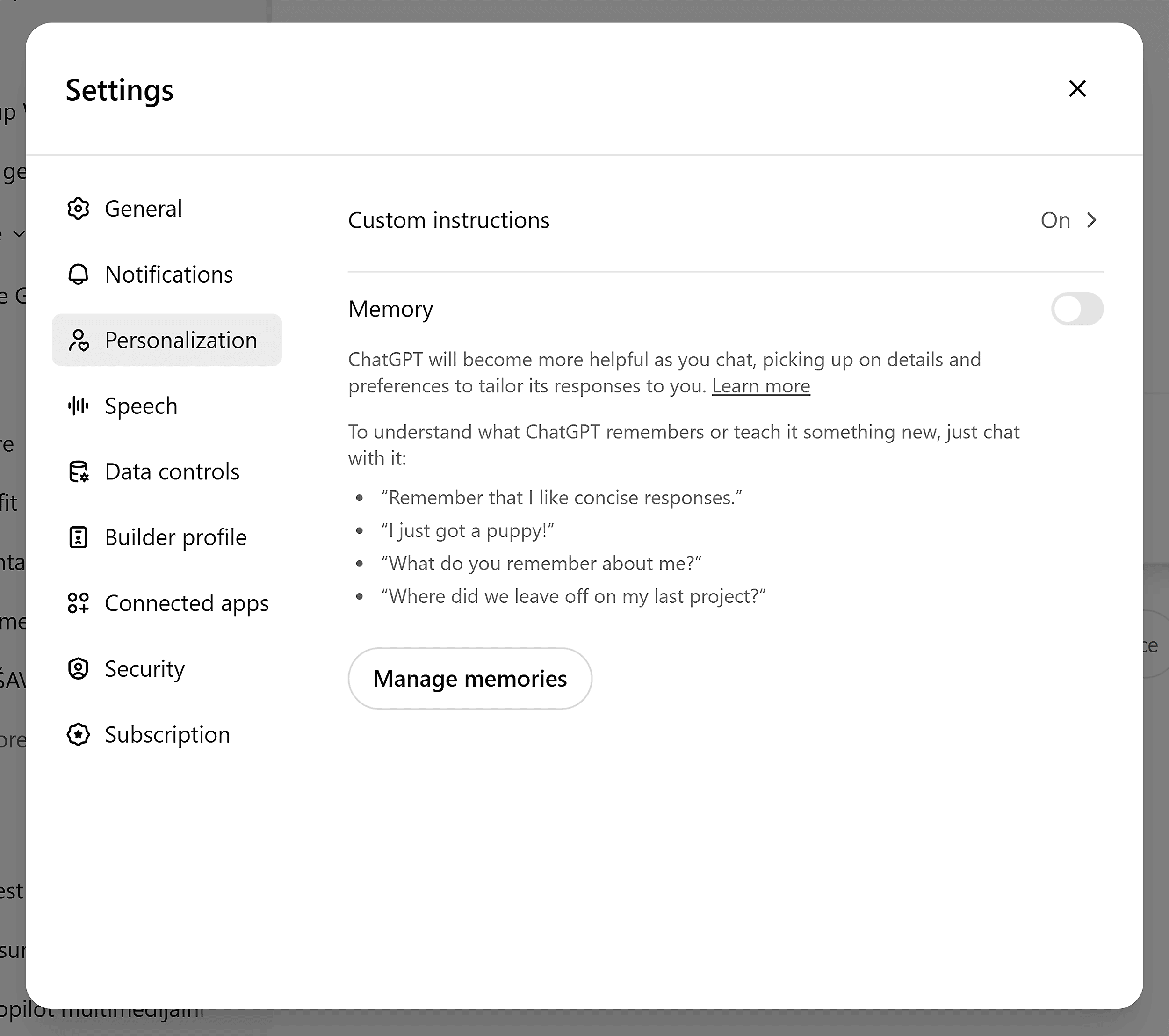
Turn memory on, and ChatGPT will learn from your past conversations.
You won’t have to repeat yourself every time you start a new chat.
Over time, it’ll remember details and give you more relevant responses.
Turn memory off and every session starts fresh.
This is great if you prefer more privacy.
Or don’t want past conversations influencing future replies.
You can also erase stored memories.
Click “Manage memories” in the “Personalization” window.
And you’ll see a new window where you can erase all memories or delete specific ones.
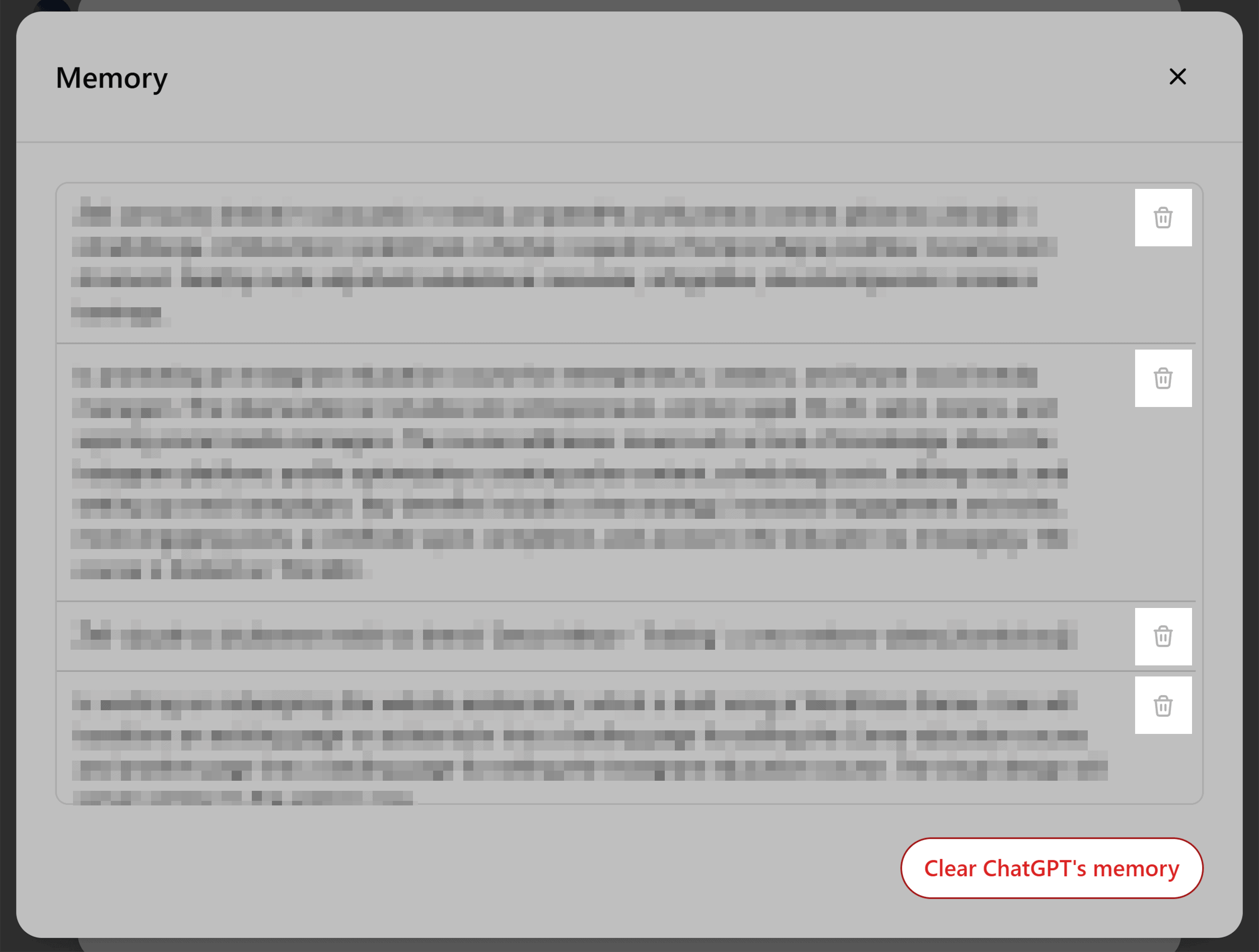
Personalizing ChatGPT: Make It Work Your Way
ChatGPT doesn’t have to sound the same for everyone.
You can easily customize it.
Just go to “Profile” (at the top right) > “Customize ChatGPT.”
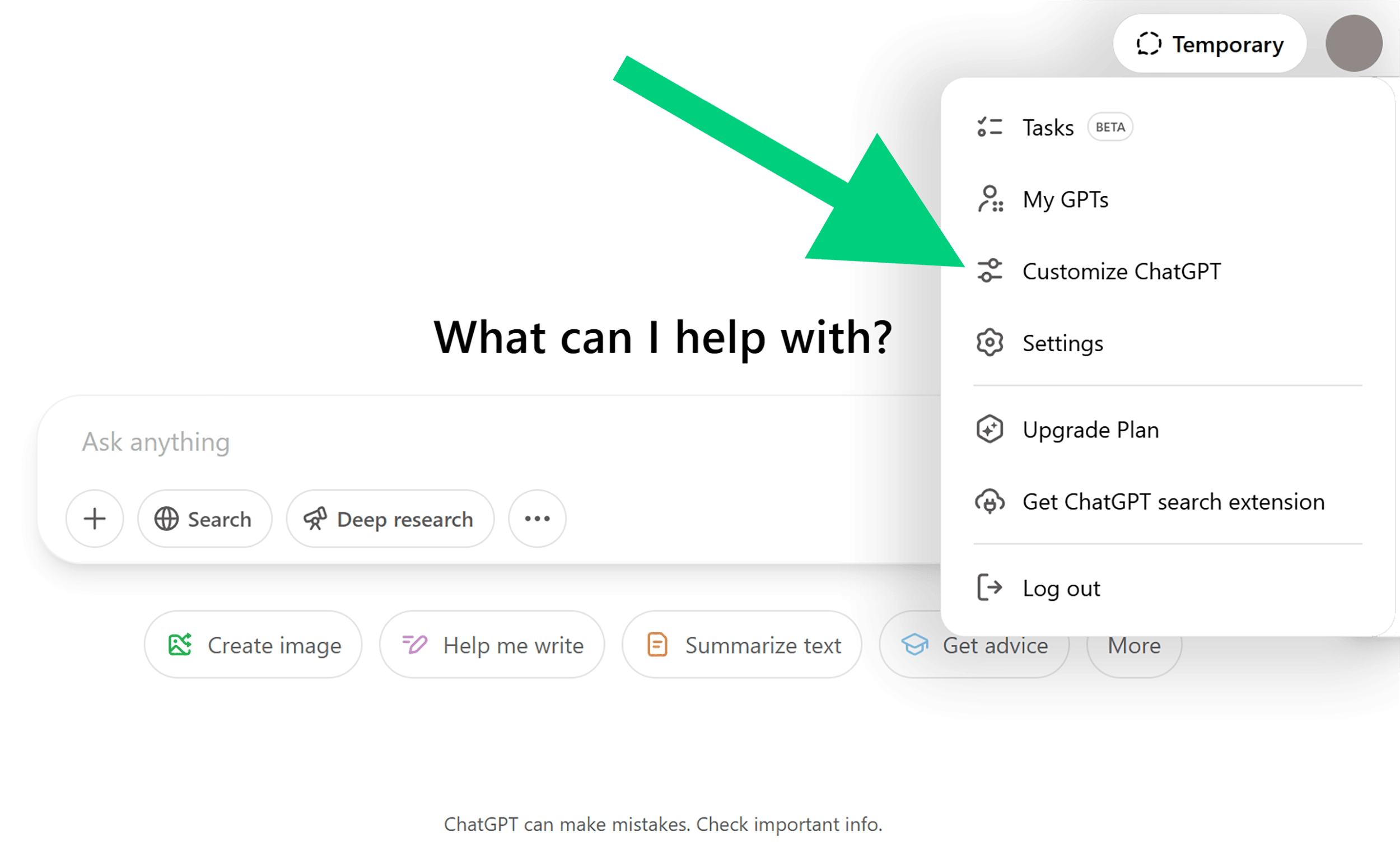
Then, enter basic details like your name and profession.
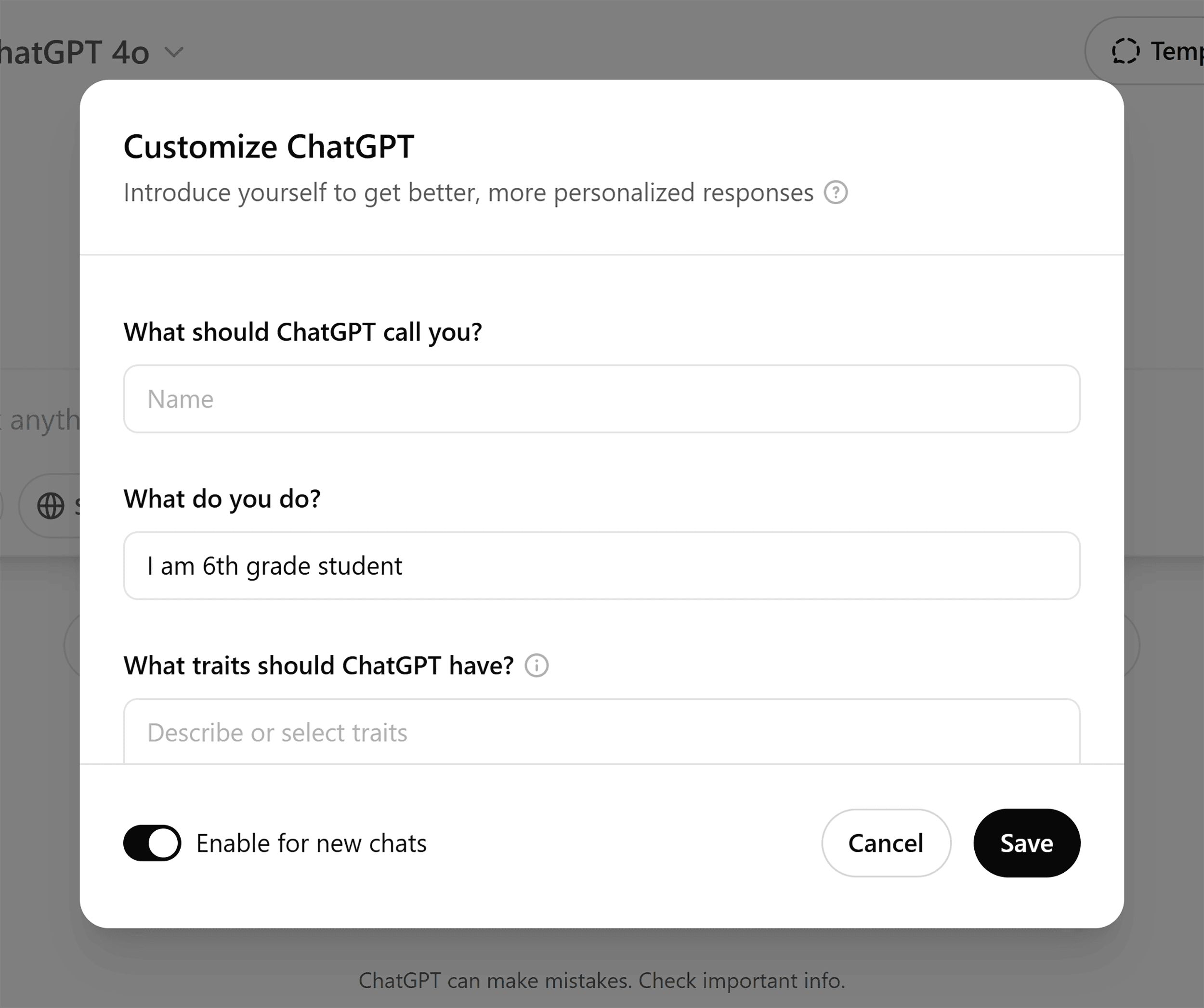
Next, customize ChatGPT’s personality.
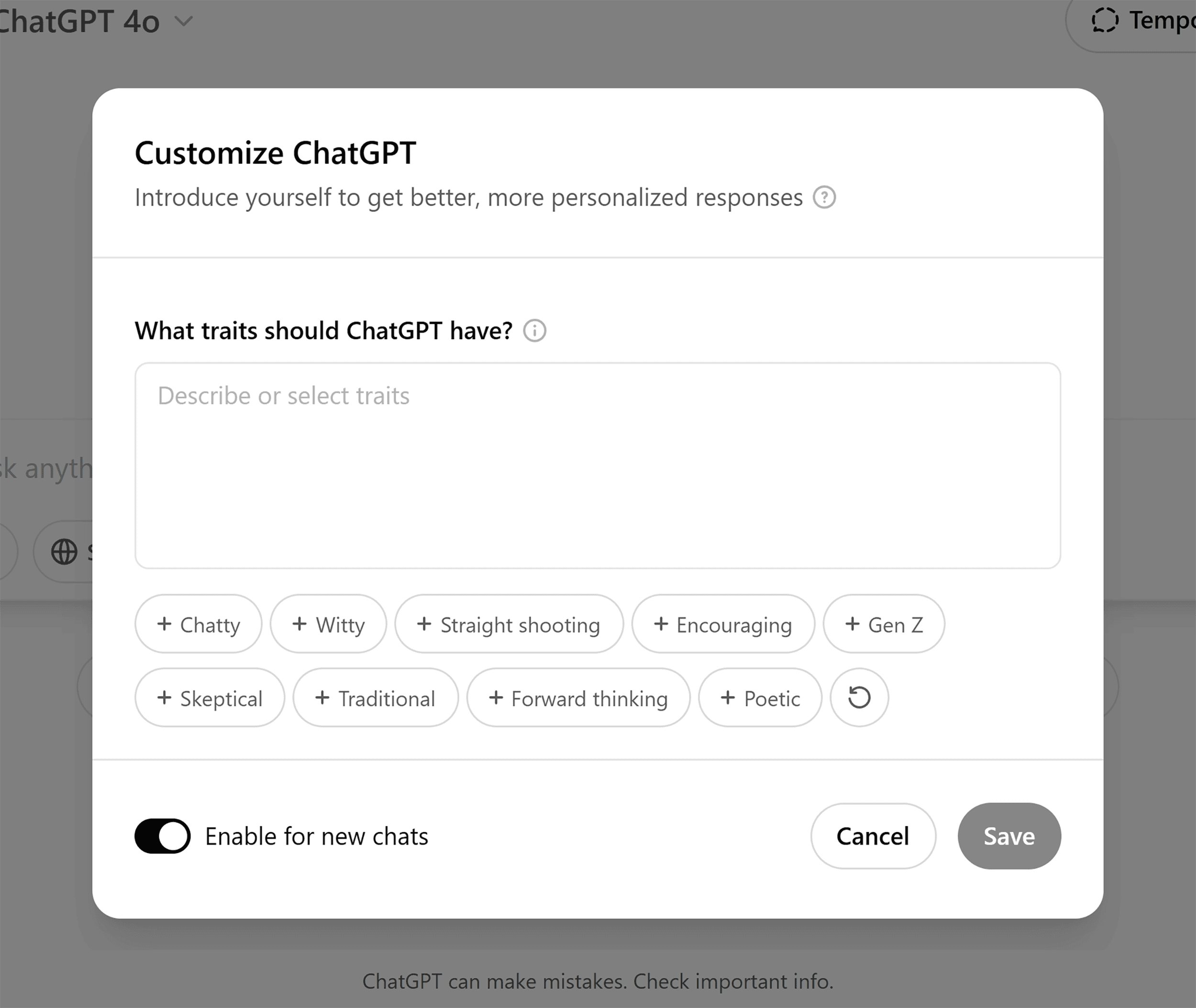
You can specify:
Tone: Friendly, casual, professional? Response length: Brief and direct or in-depth? Persona: Strategist, a teacher, or something else?For example, if you want it to write in Backlinko style, you could type:
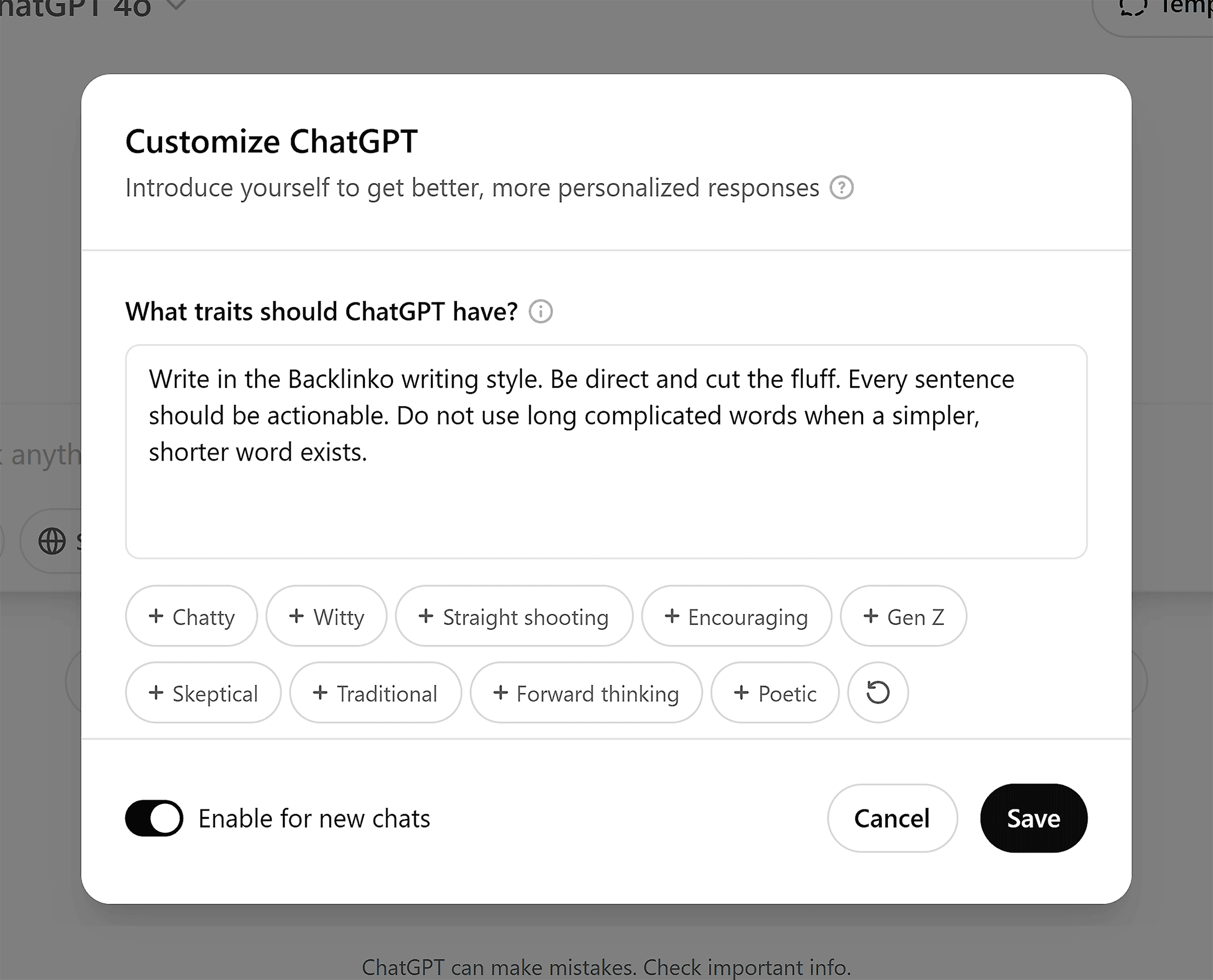
If you’re not sure what to write, you can ask ChatGPT.
Here’s one way you can do that using your brand’s messaging document.
Upload the brand guide to ChatGPT and write:
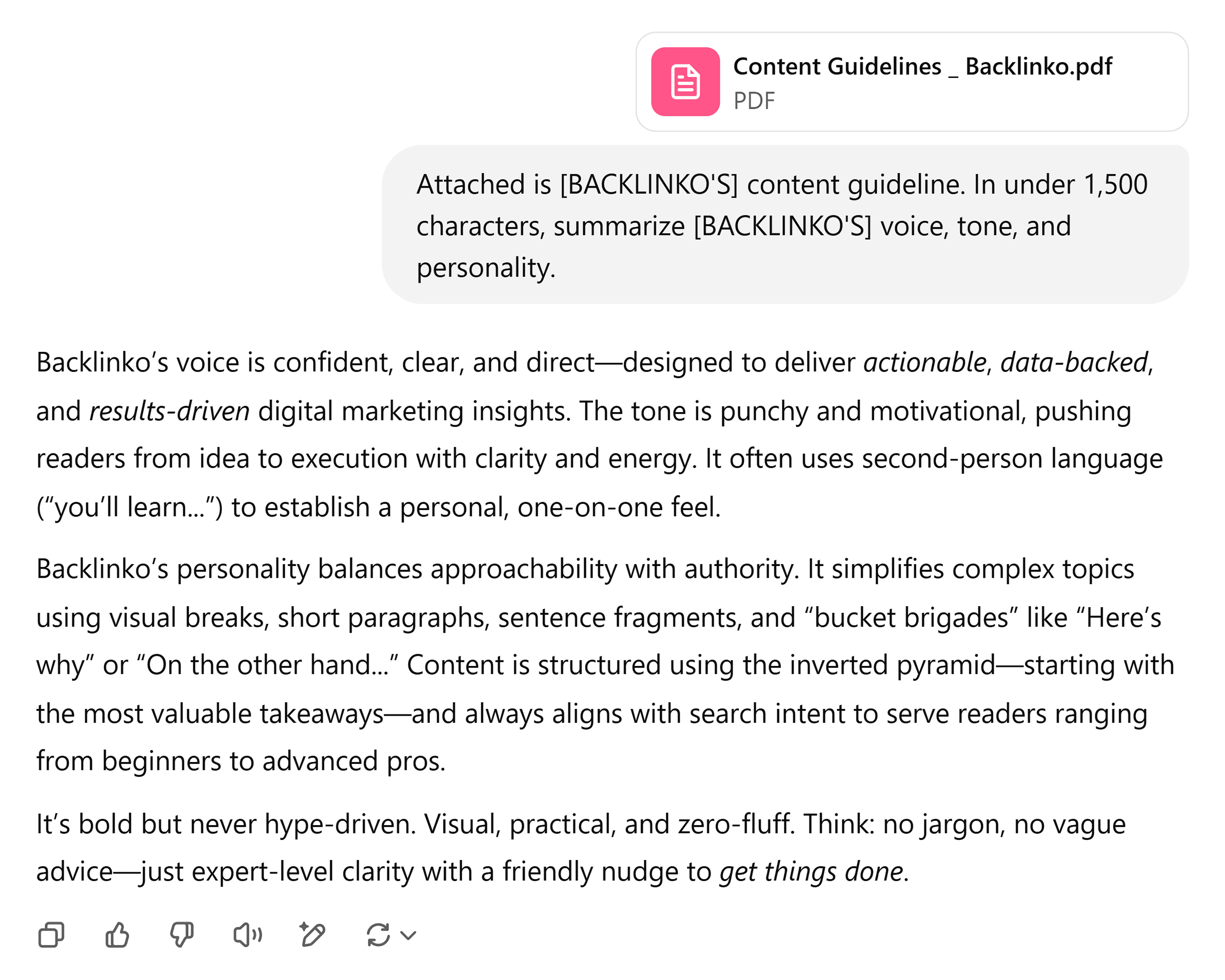
The final section in customization is “What should ChatGPT know about you?”
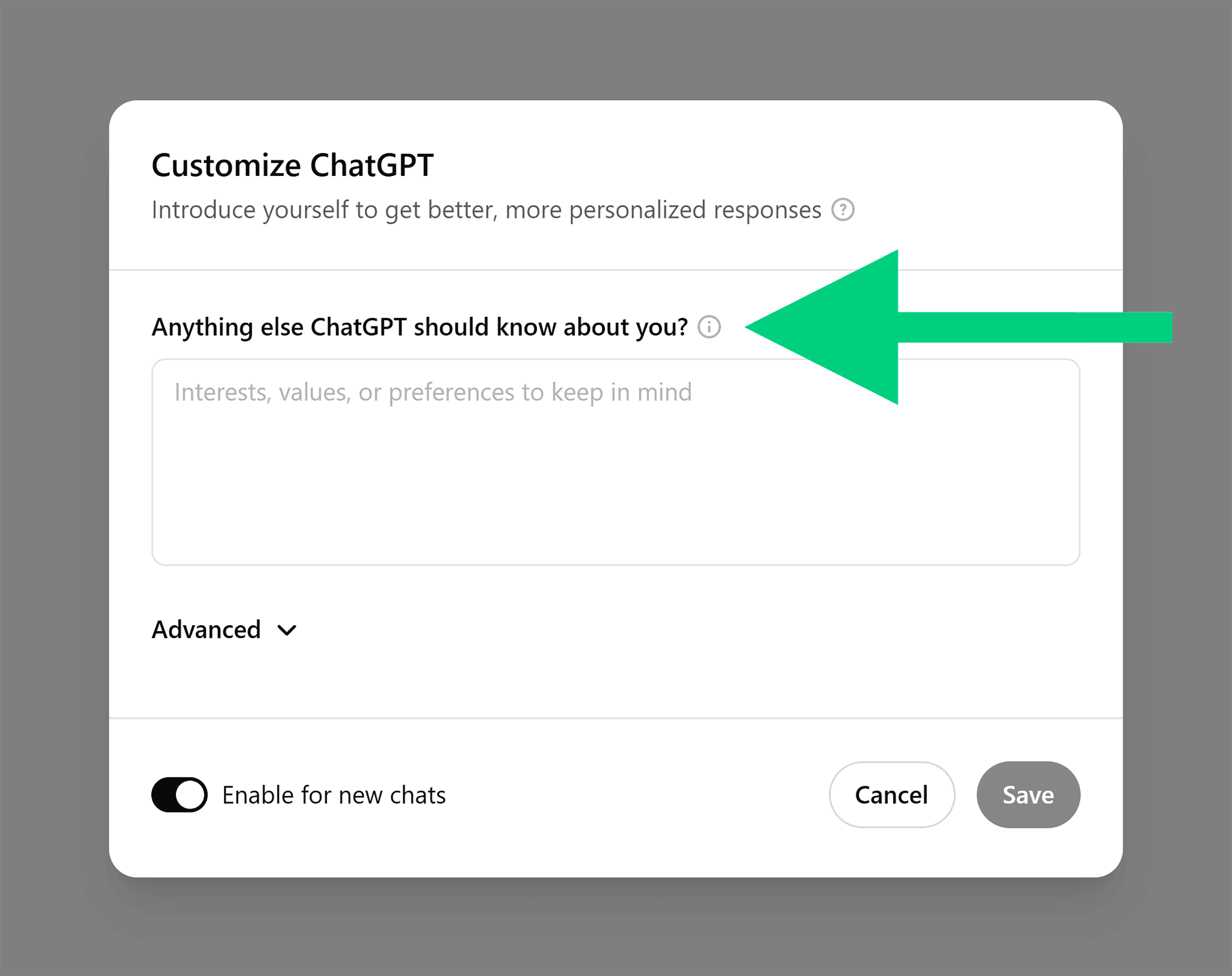
Here, you personalize ChatGPT to your life and work.
What should you add?
Think about how you’ll be using it, then add relevant instructions.
For example, if you’re vegetarian with some dietary restrictions and you often use it for meal planning, you can write:
Here’s another example if you use ChatGPT for work.
Say you have an ecommerce store.
You could add:
Control Your Privacy
By default, OpenAI may use your conversations to improve the model.
If you’d rather keep chats private, you can turn this off.
Go to “Profile” > “Settings” > “Data Controls” and toggle “Improve the model for everyone.”
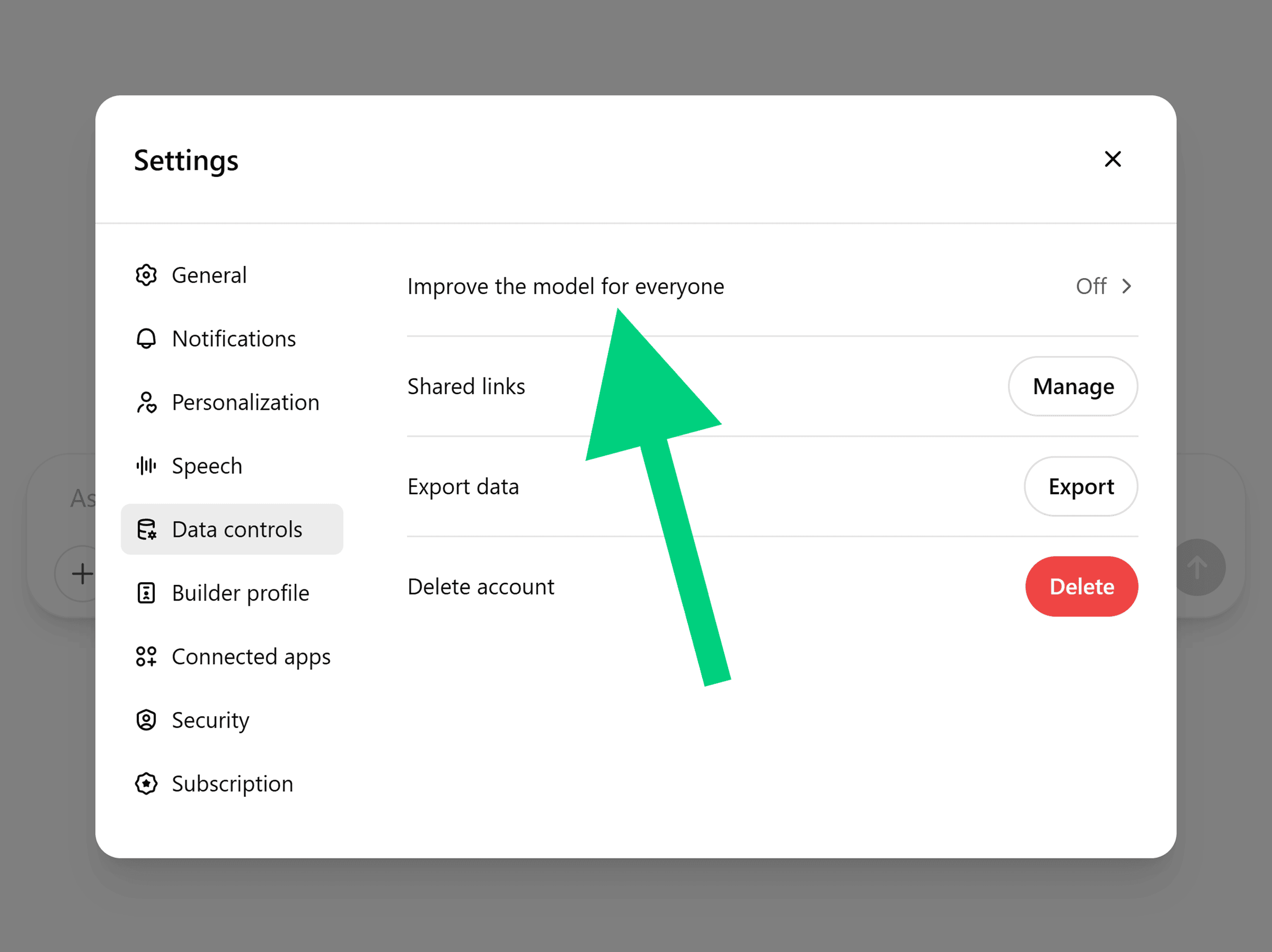
Once you do this, it won’t use your conversations for training.
And that’s it.
Your AI is now customized for you.
Go test ChatGPT with a few questions.
And see how well it adjusts based on your customizations.
Still not customized the way you want it?
Go back to settings and keep refining.
Step 3: Learn to Write Better Prompts
If you want high-quality answers from ChatGPT, you need to write better prompts.
Bland or generic answers usually mean a prompting problem.
Why?
Because when you give ChatGPT a vague question, it has to fill in the gaps.
And from what I’ve seen, it plays it safe by giving you the most generic explanations.
You don’t want that.
So how do you fix it?
Let’s get Google to help.
In its prompting guide, Google states that a good, detailed prompt includes four elements:
Task: What you want ChatGPT to do (explain, analyze, compare) Context: Relevant background info (who, what, where, why) Persona: The role ChatGPT should take (expert, teacher, consultant) Format: How the response should be structured (step-by-step, bullet points, examples)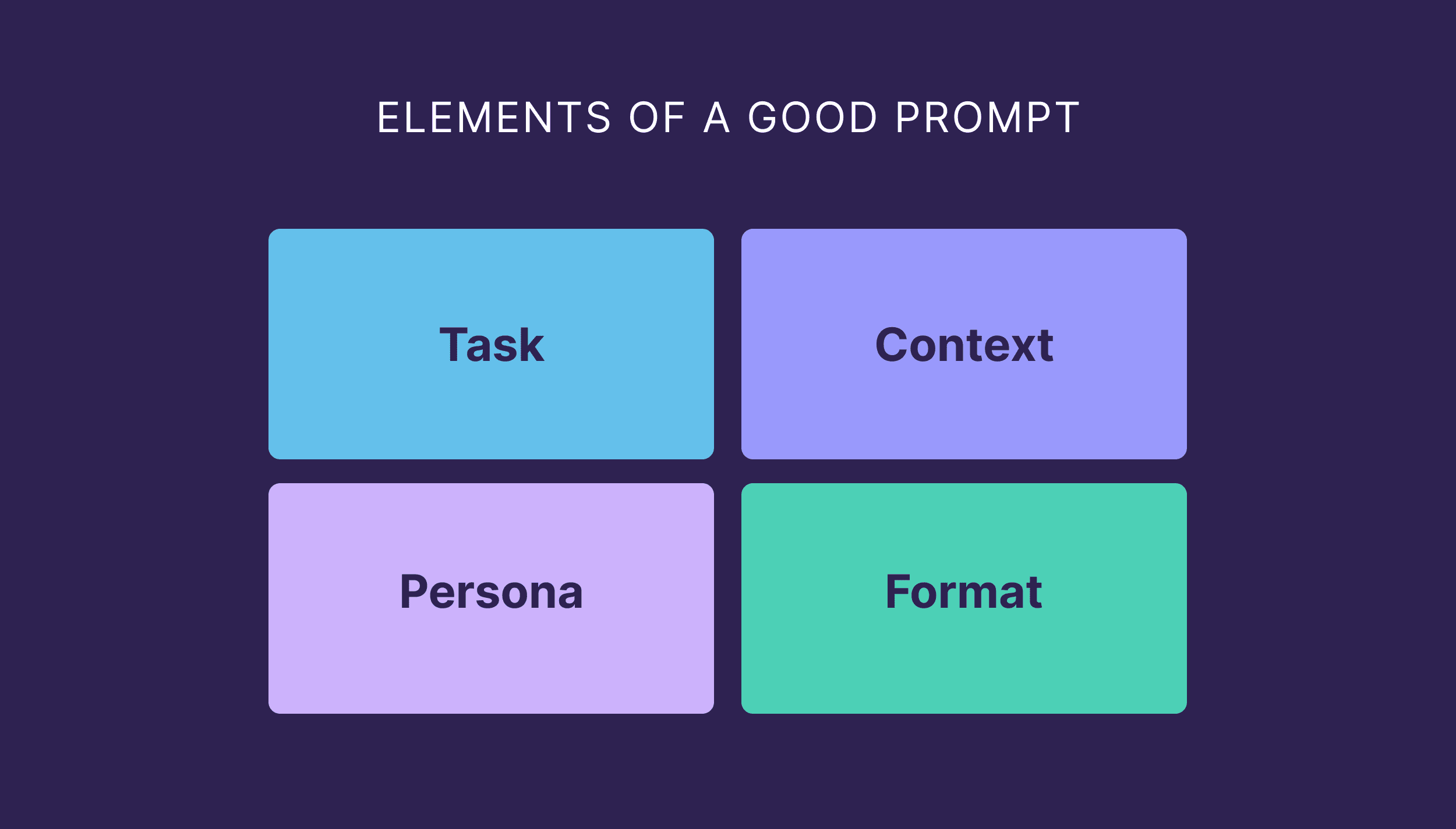
Adding just task + context makes a big difference.
Use all four, and you get much better answers.
Let me show you the difference in answer quality between a basic and an optimized prompt.
A basic prompt:
What do you get?
A generic list that can work for any tour guide anywhere in the world:
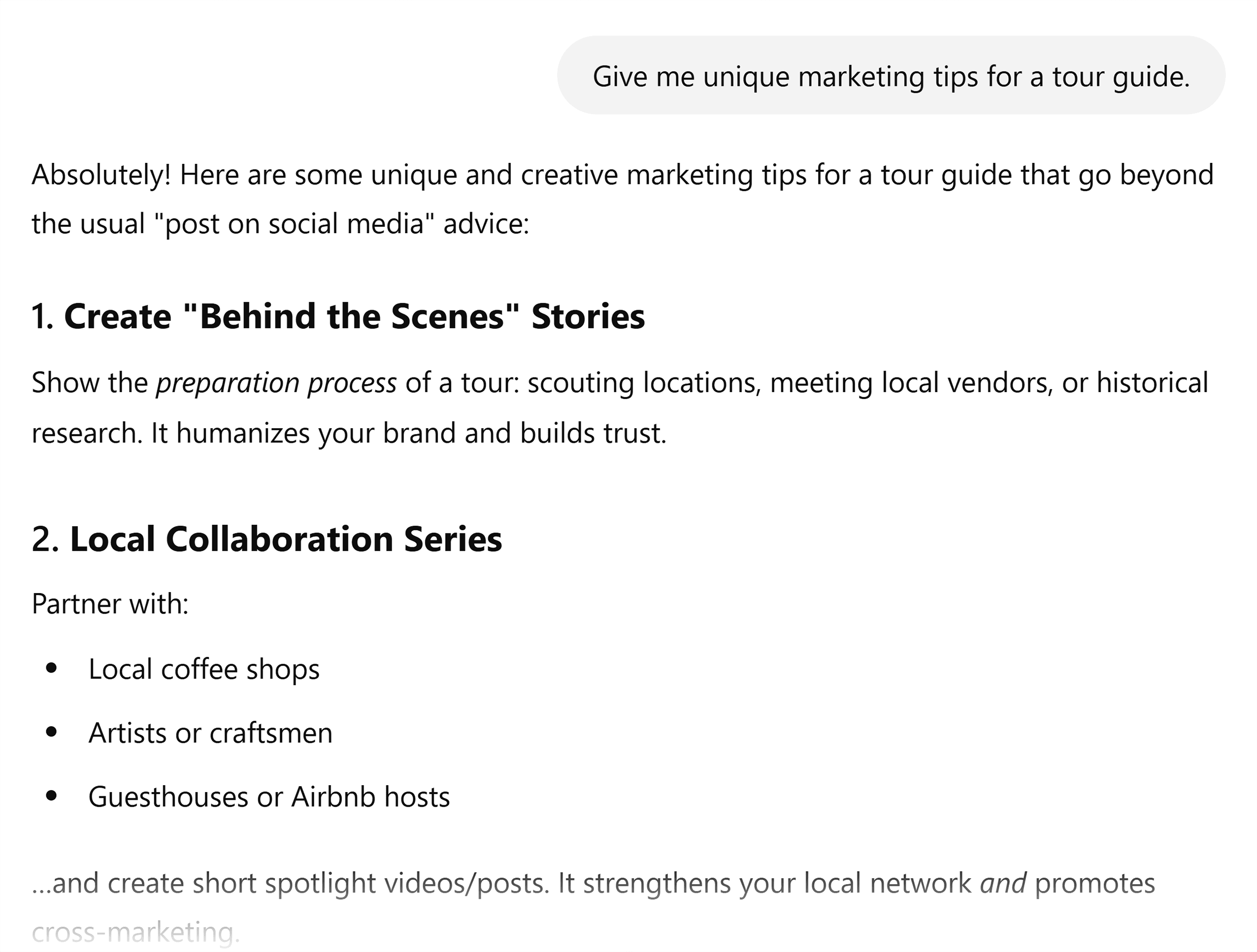
Now, add task + specific context:
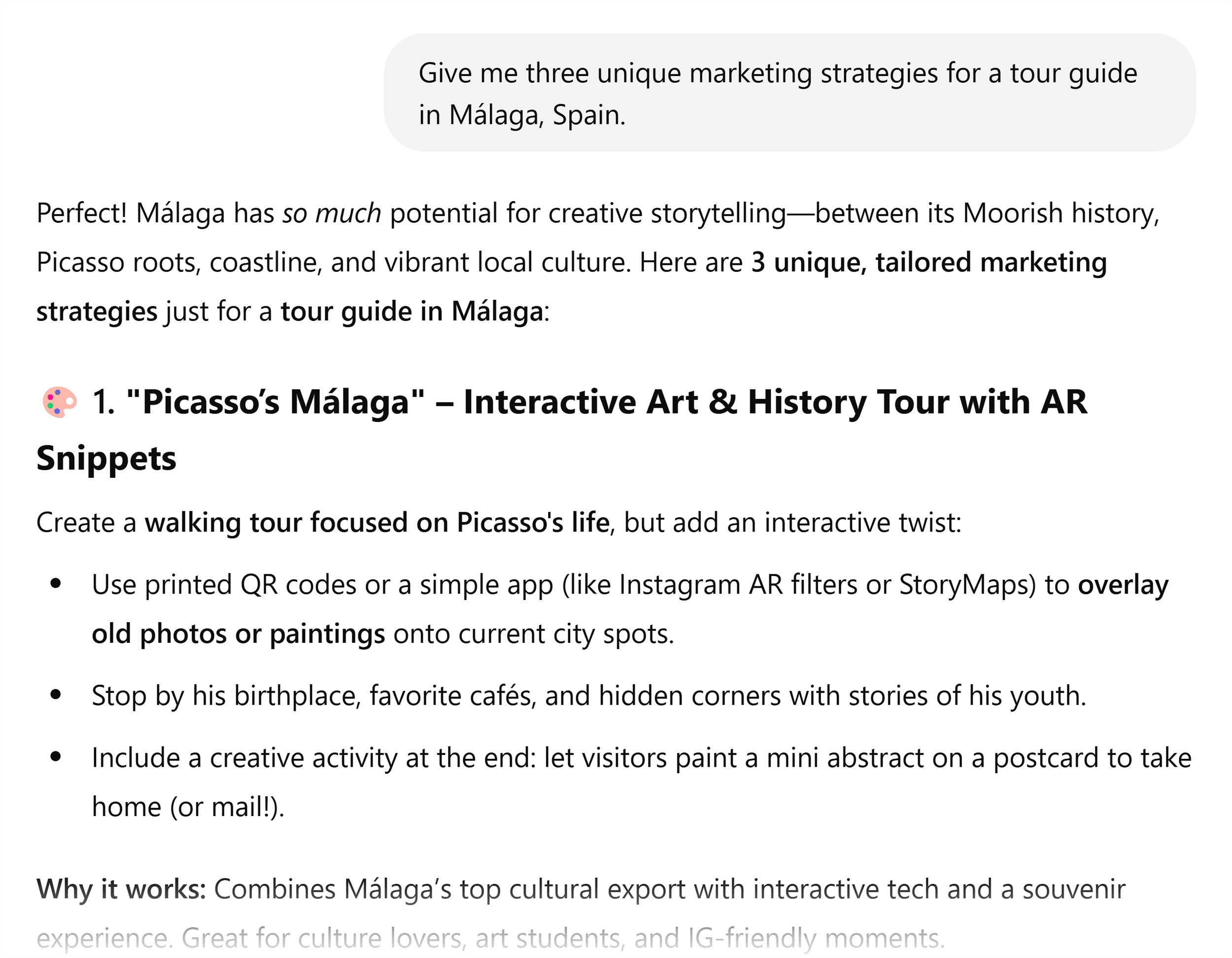
Since ChatGPT has specific details to work with, the answer is more relevant.
We’re not done yet.
How about using all four elements using this prompt?
That level of detail gives you a more hyper-specific answer:
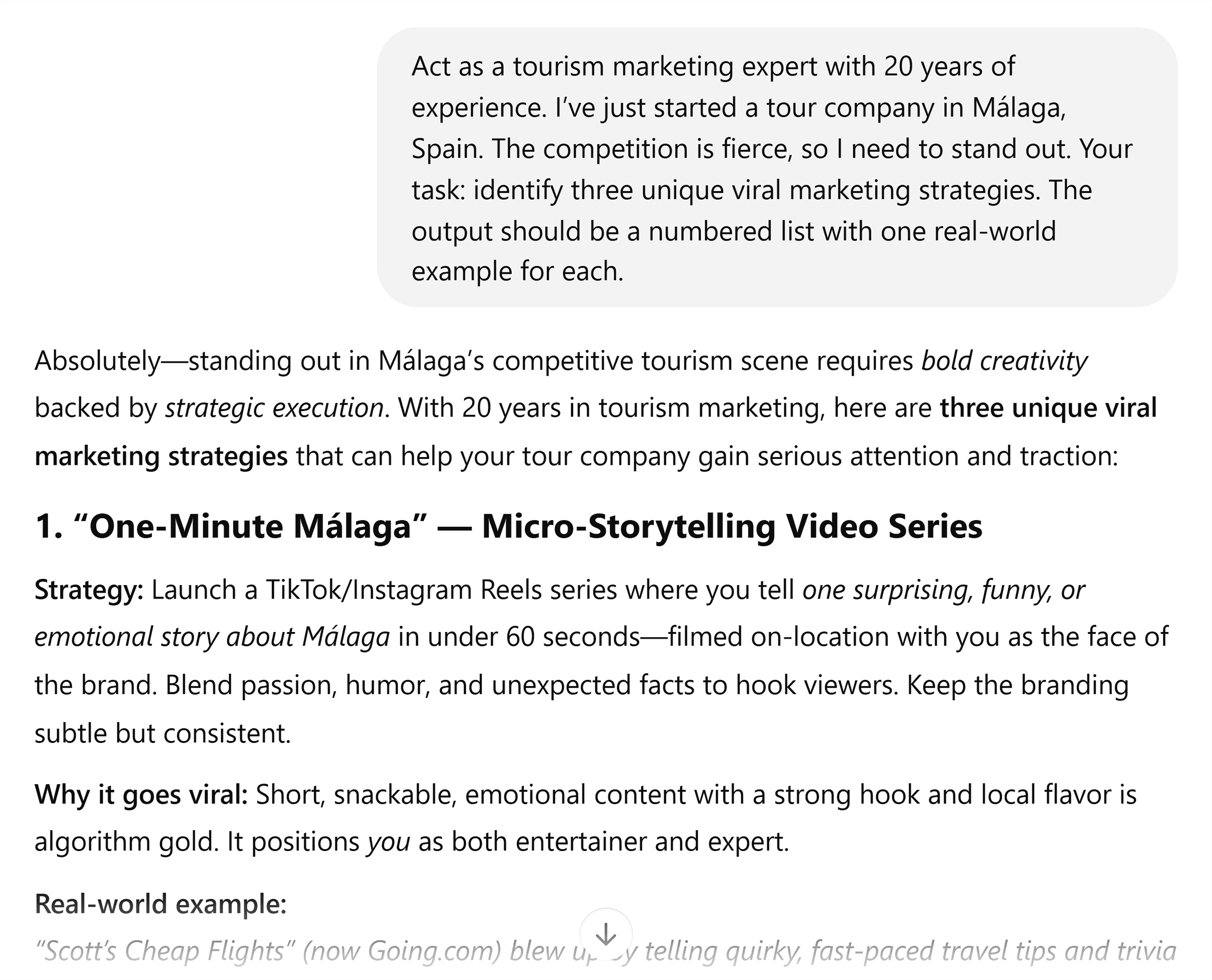
Step 4: Get Better Results With Frameworks
Frameworks help ChatGPT focus its thinking so its response becomes clearer and more organized.
So, instead of saying, “Give me an SEO strategy,” or “Give me content ideas,” specify a framework.
For example, in the Málaga tour guide prompt above, try using the STP framework (Segmentation, Targeting, Positioning).
You might say:
Much. Better. Answer.
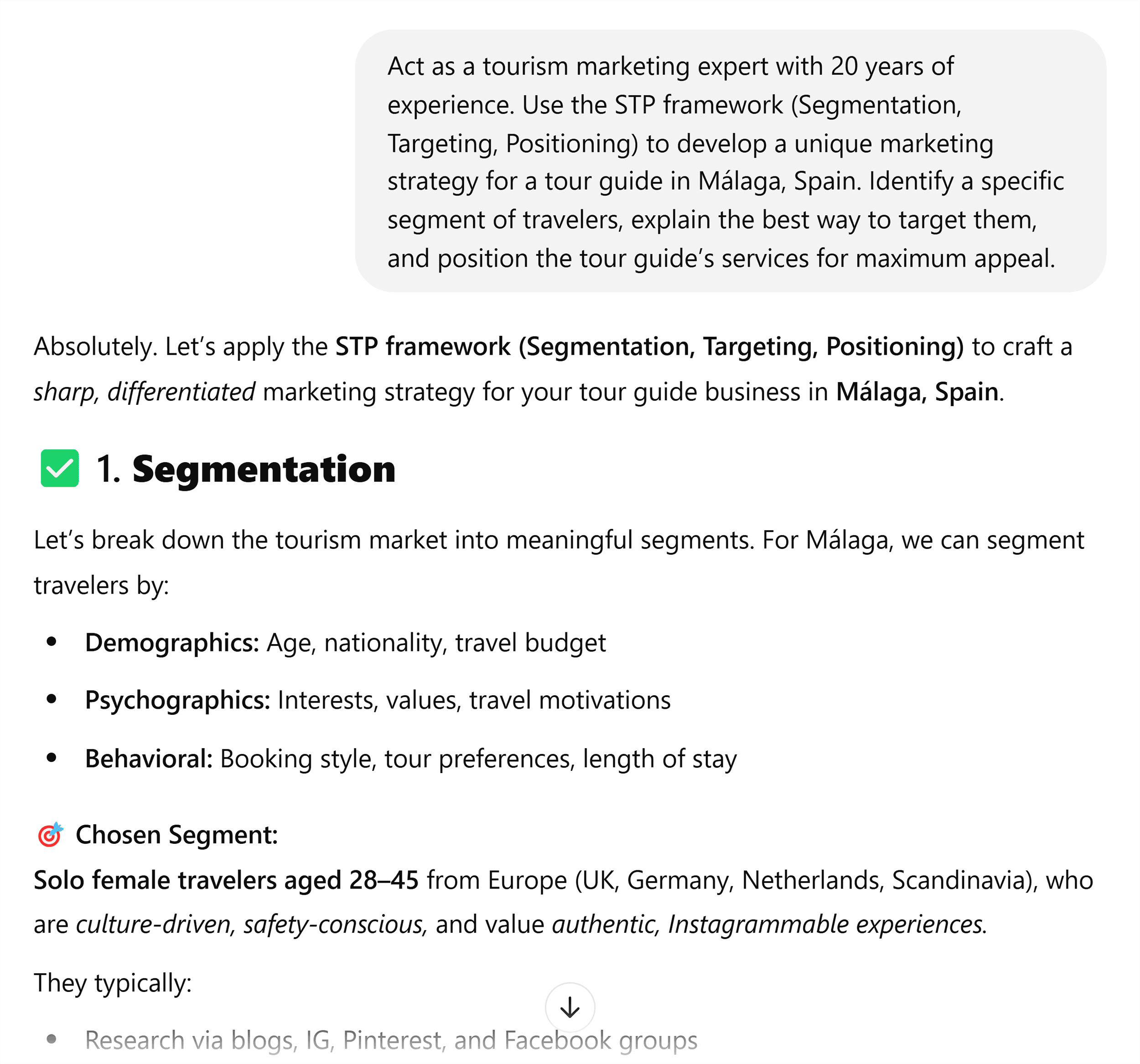
But what if you don’t know any frameworks?
No problem.
Just ask ChatGPT.
All you have to do is choose the best one.
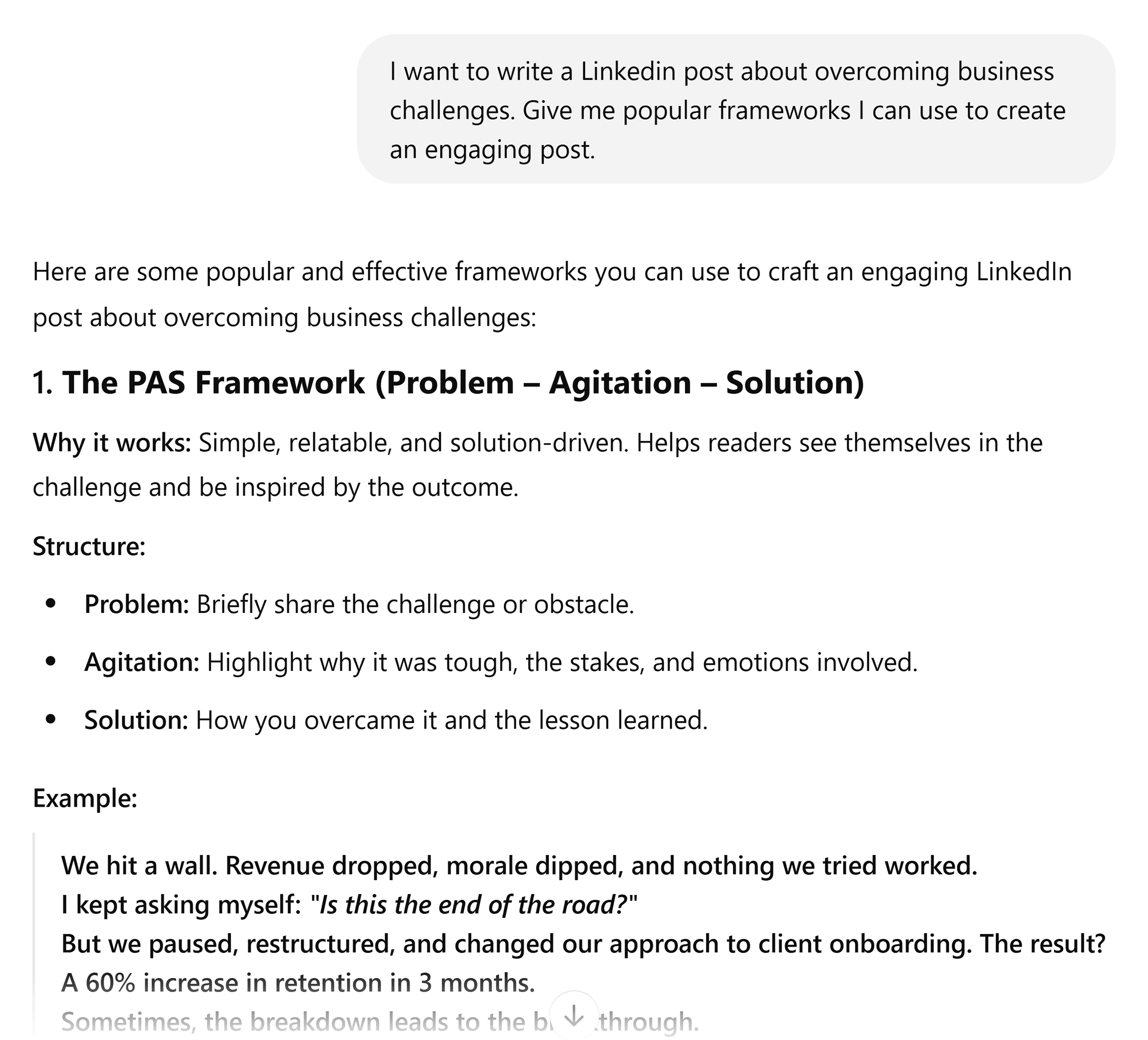
Step 5: Refine ChatGPT’s Responses with Follow-Ups
ChatGPT’s first answer isn’t always the best, especially for complex topics.
How do you improve it?
Keep asking questions.
Here’s what I mean.
Imagine you’re a social media manager launching a smart water bottle that reminds users to drink.
Your first prompt might be:
ChatGPT gives you a list:
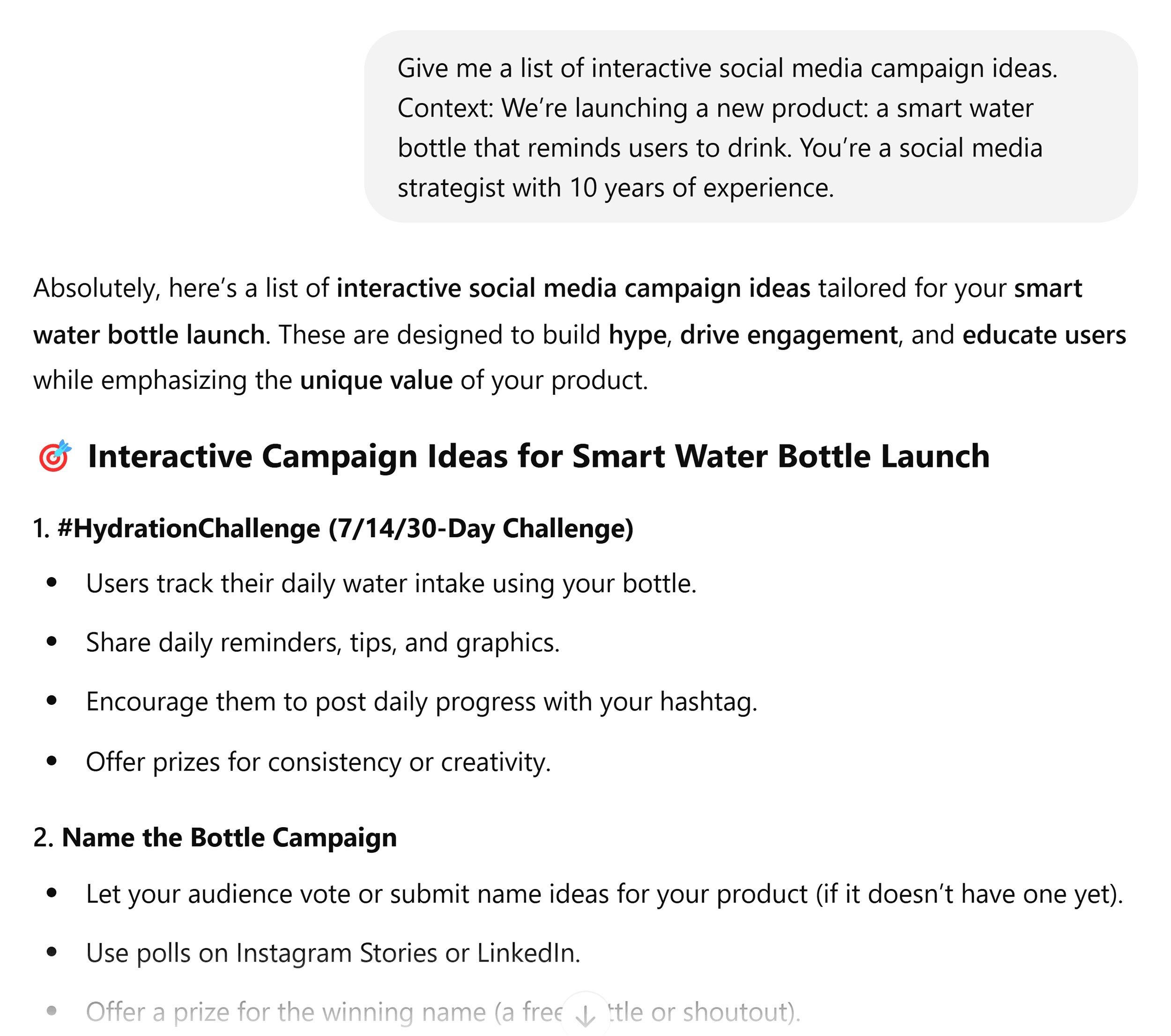
It’s a good start.
But it’s not enough to have a clear launch strategy.
So, you dig deeper.
If the reply is too generic, ask for more details. If the answer is too theoretical, ask for clear, actionable steps.Or you can focus on one thing in the list.
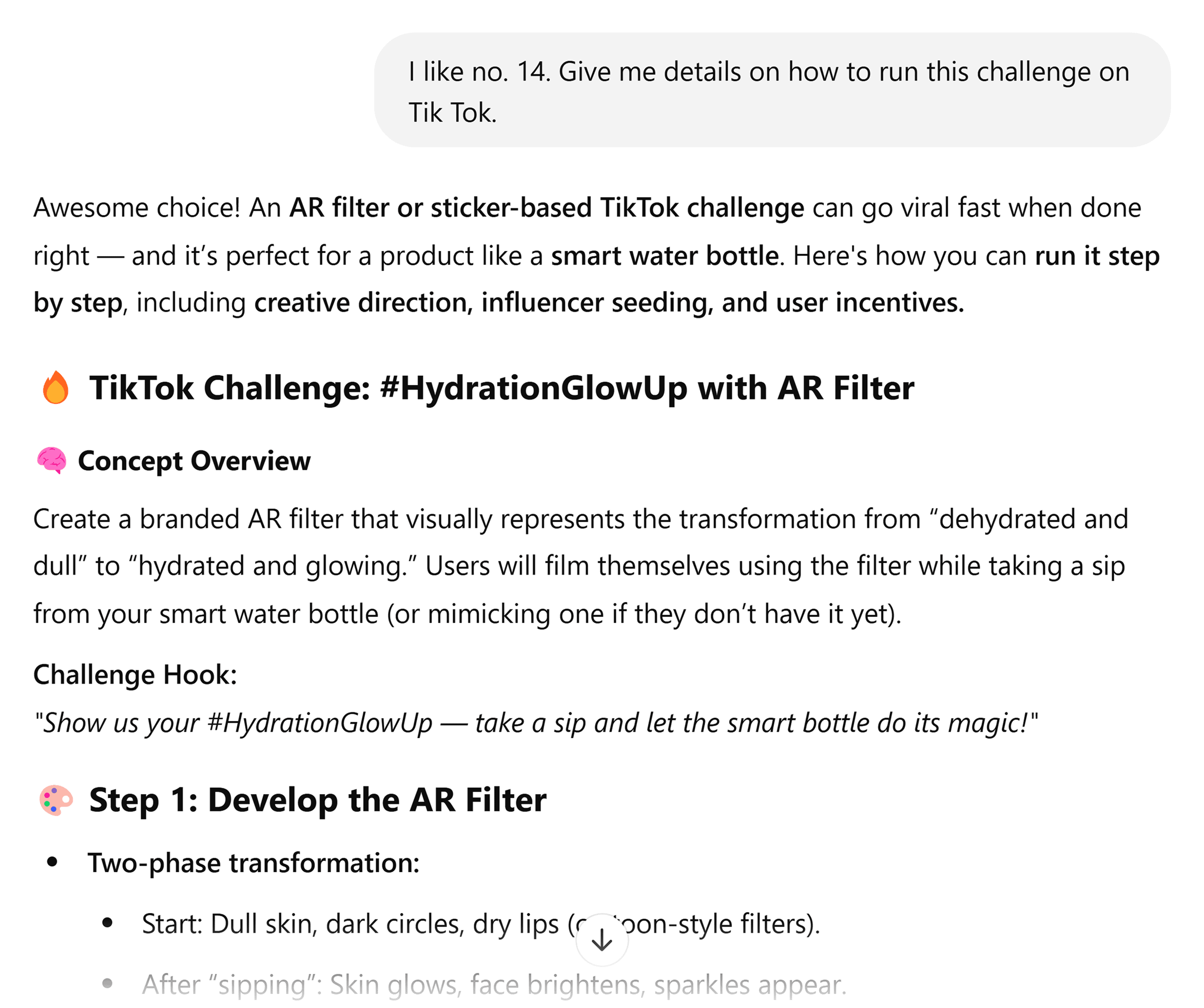
Keep refining your questions until you have everything you need.
By doing this, ChatGPT becomes more of a collaborative partner.
And you get a final output that’s a blend of AI and your knowledge and topical expertise.
Why not add everything in one big prompt?
You could.
But it’s not always the best approach.
Yes, some prompts are simple enough that they don’t need iterative refining.
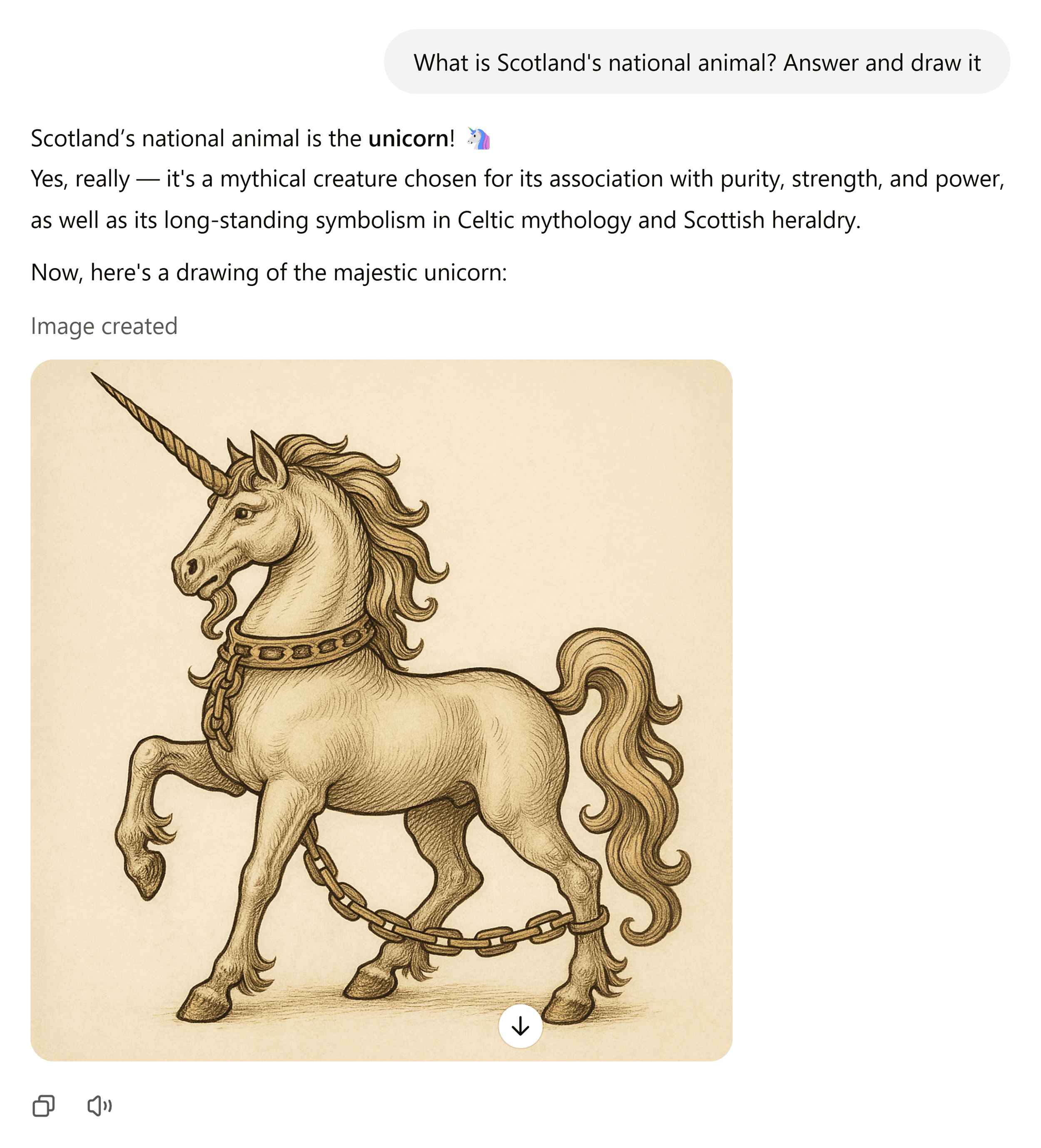
But for complex ideas, refining step by step gives you more control over the output.
Fun Ways to Use ChatGPT for Life and Work
One of the most powerful things about ChatGPT?
It can take on different roles.
It can be your personal assistant, researcher, strategist, problem-solver, and more.
ChatGPT as 24-7 Personal Assistant
ChatGPT can be your assistant for work and daily life.
Need help with life planning, SEO, or optimizing your habits?
Done.
For example, you can use it to review legal documents.
Upload a PDF, like a client agreement, and ask it to explain the legal jargon. Or point out unfair clauses.
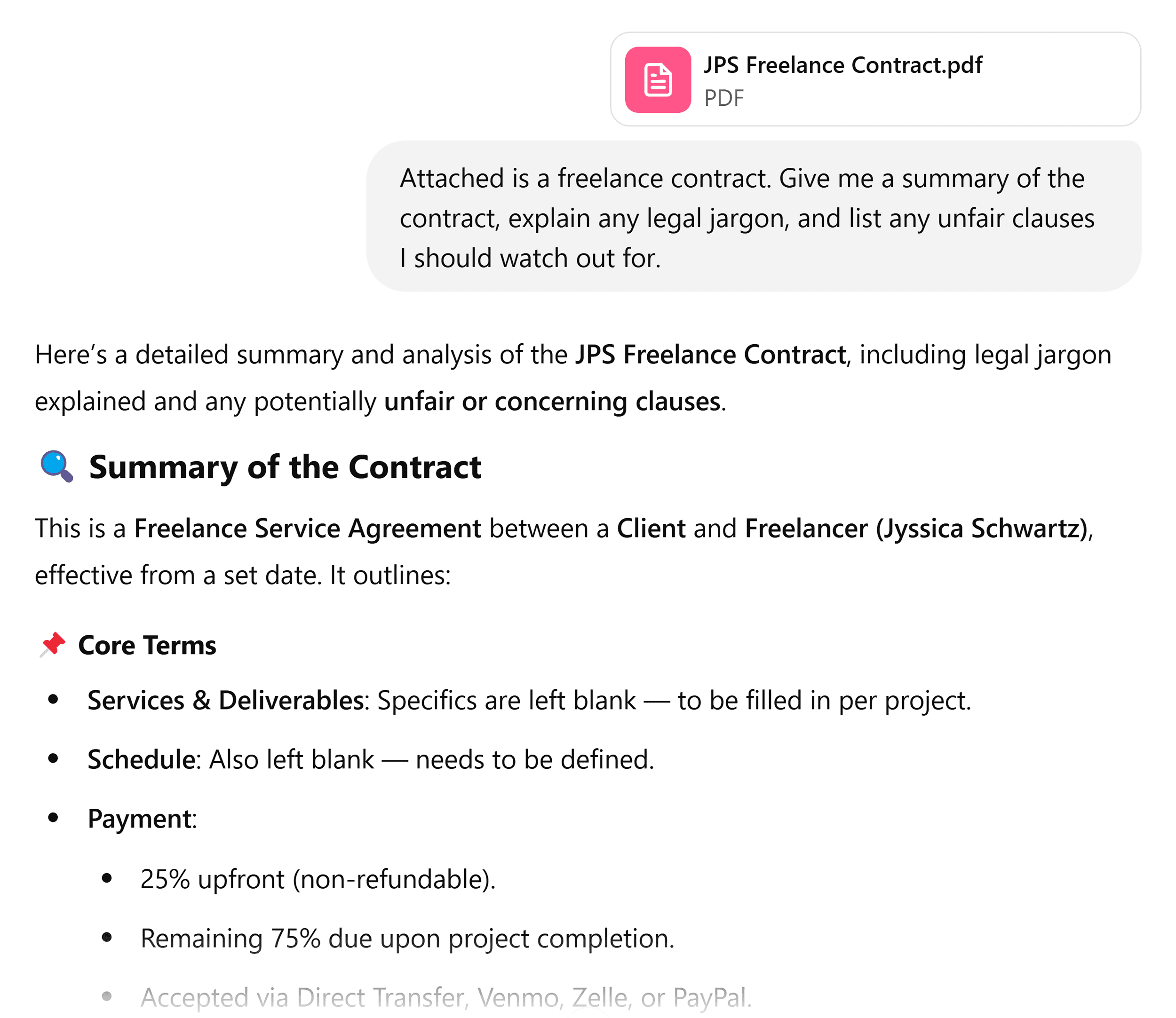
It’s great for mundane tasks, too. Like cleaning up video transcripts.
Paste (or upload) the transcript.
And ask ChatGPT to organize it better.
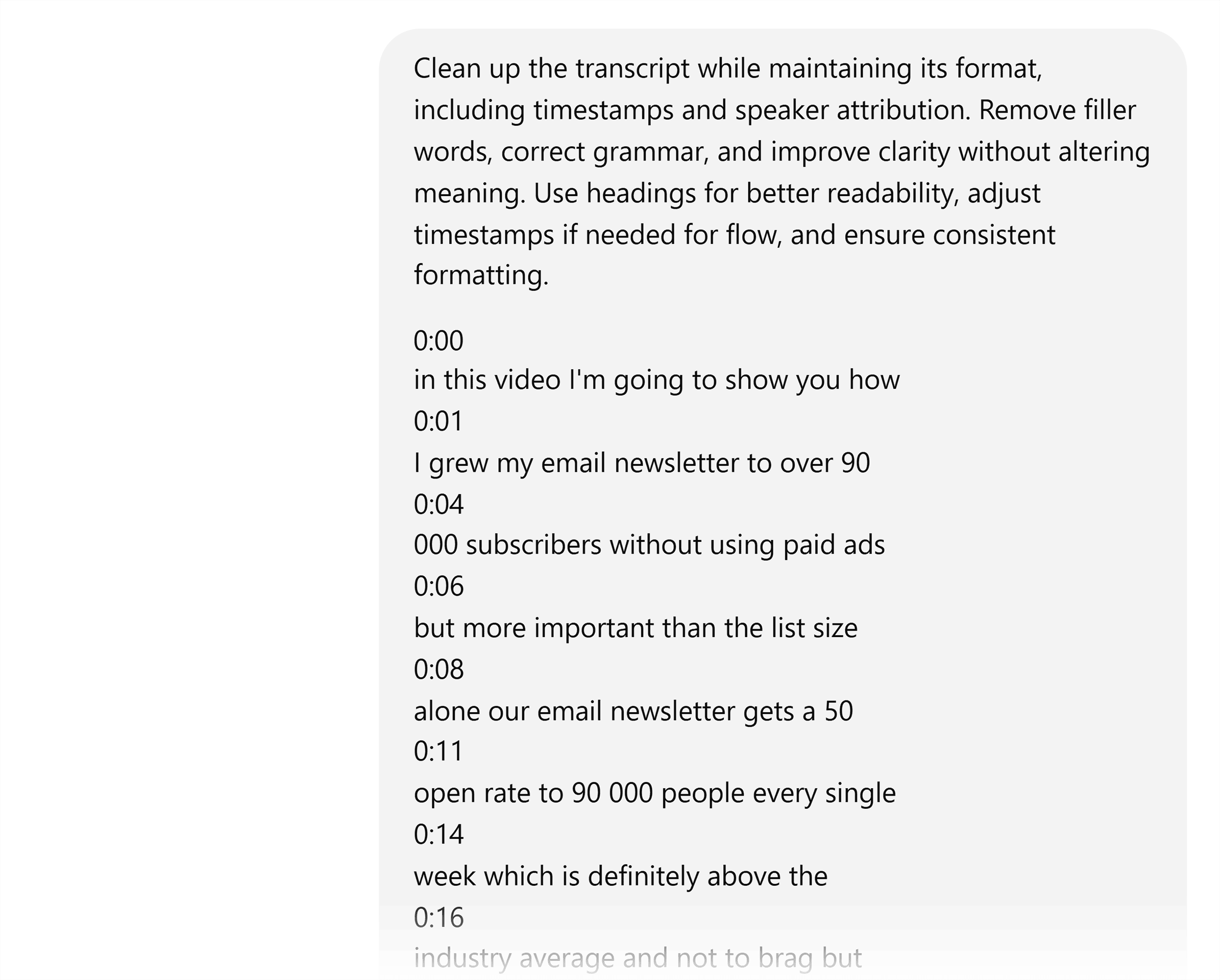
Saves you so much time.
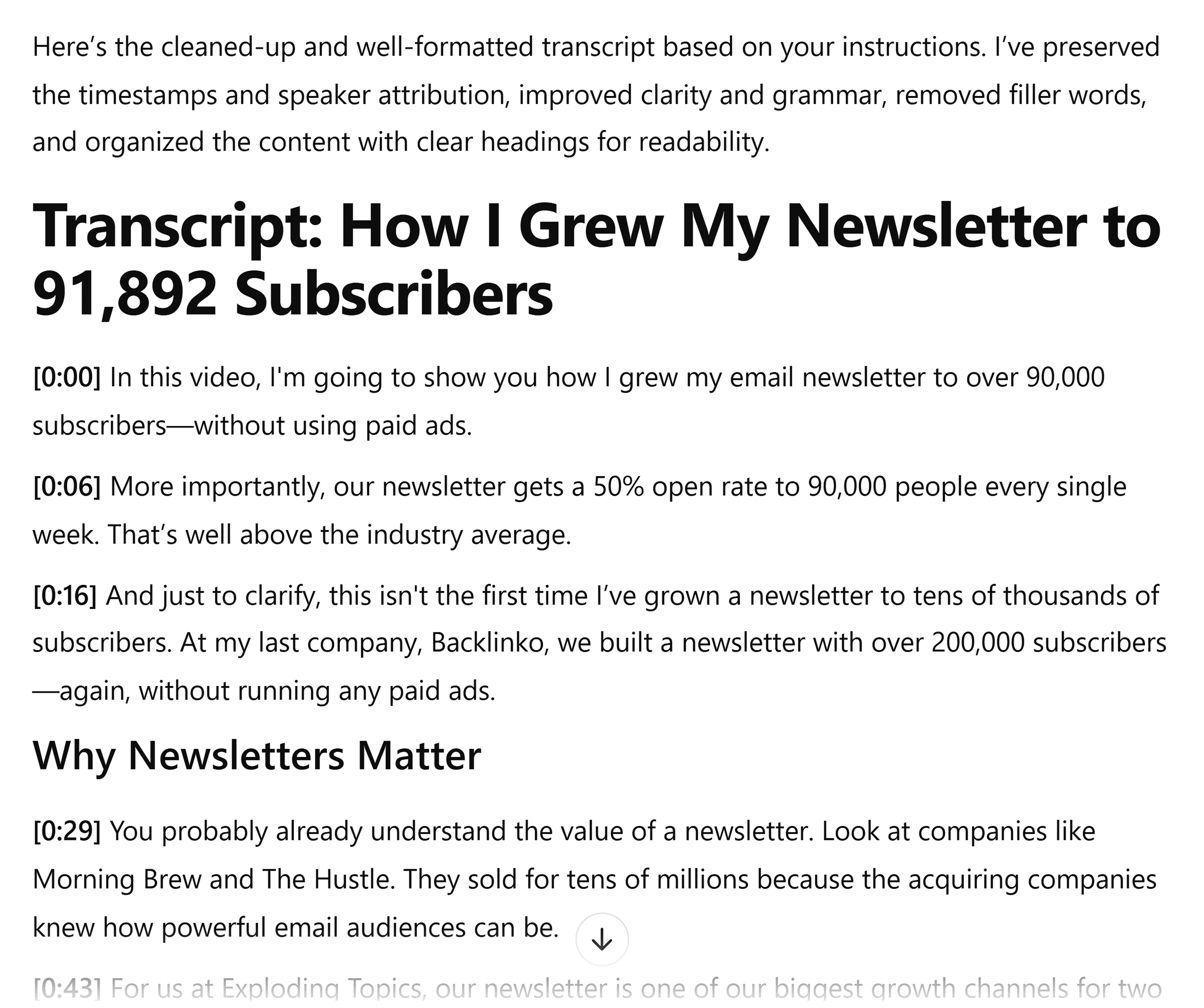
So, off to ChatGPT I went and wrote this prompt:
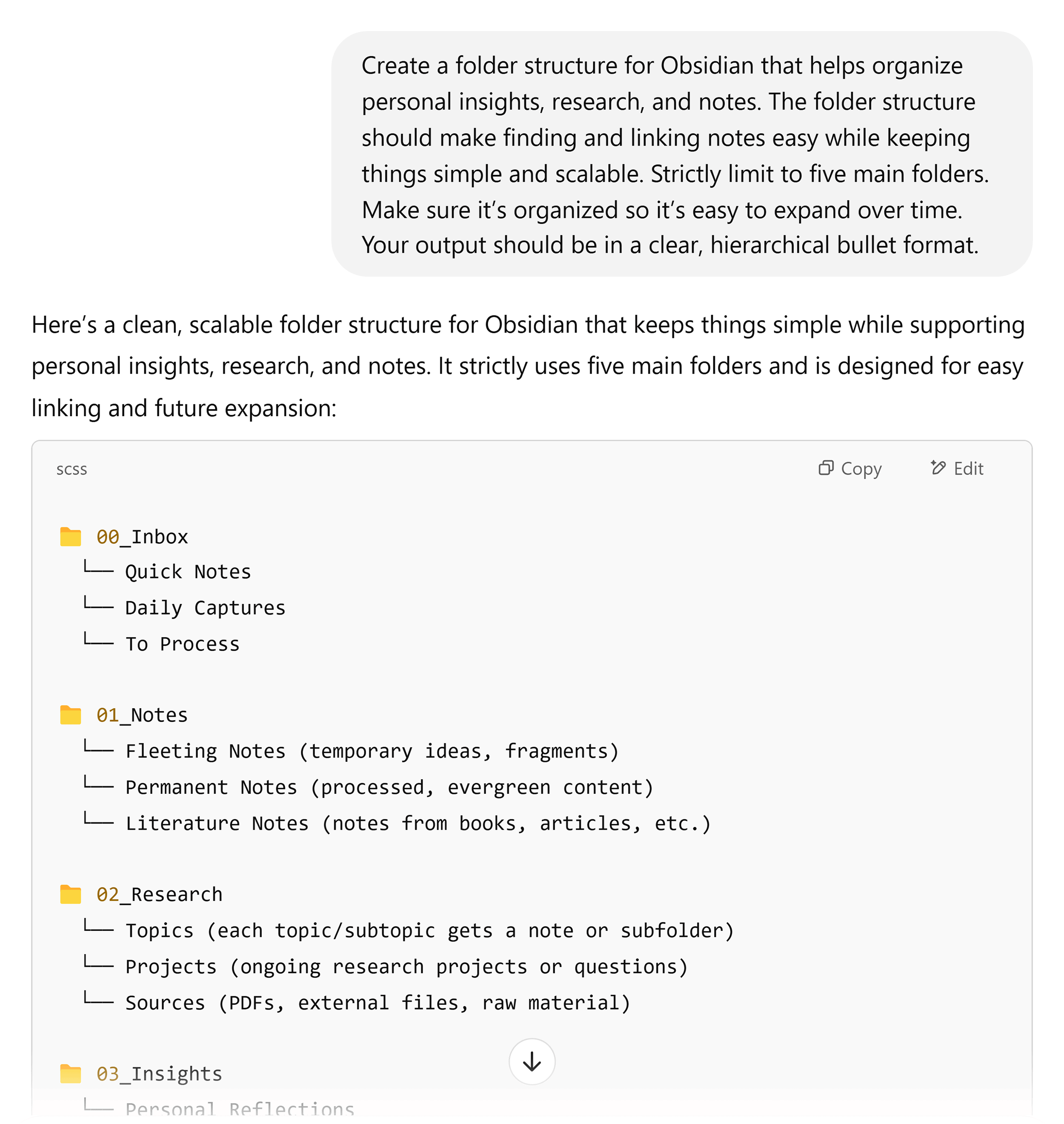
This response gave me a solid starting point to structure my folders.
It also saved me time by giving me a clear framework to customize instead of figuring it all out from scratch.
ChatGPT as Your Analyst
ChatGPT is also great for processing and analyzing data.
A few things it can do:
Clean up raw data Identify patterns Extract insightsHere’s a great example of how you can use its data analysis capabilities for digital marketing.
Let’s say you run an online store.
You want to analyze your competitor’s Google Shopping Ads using the Product Listing Ads (PLAs) data you got from Semrush.
Do this:
Upload the data to ChatGPT and use this prompt:
Just like that, ChatGPT will identify patterns and trends from the Semrush data:
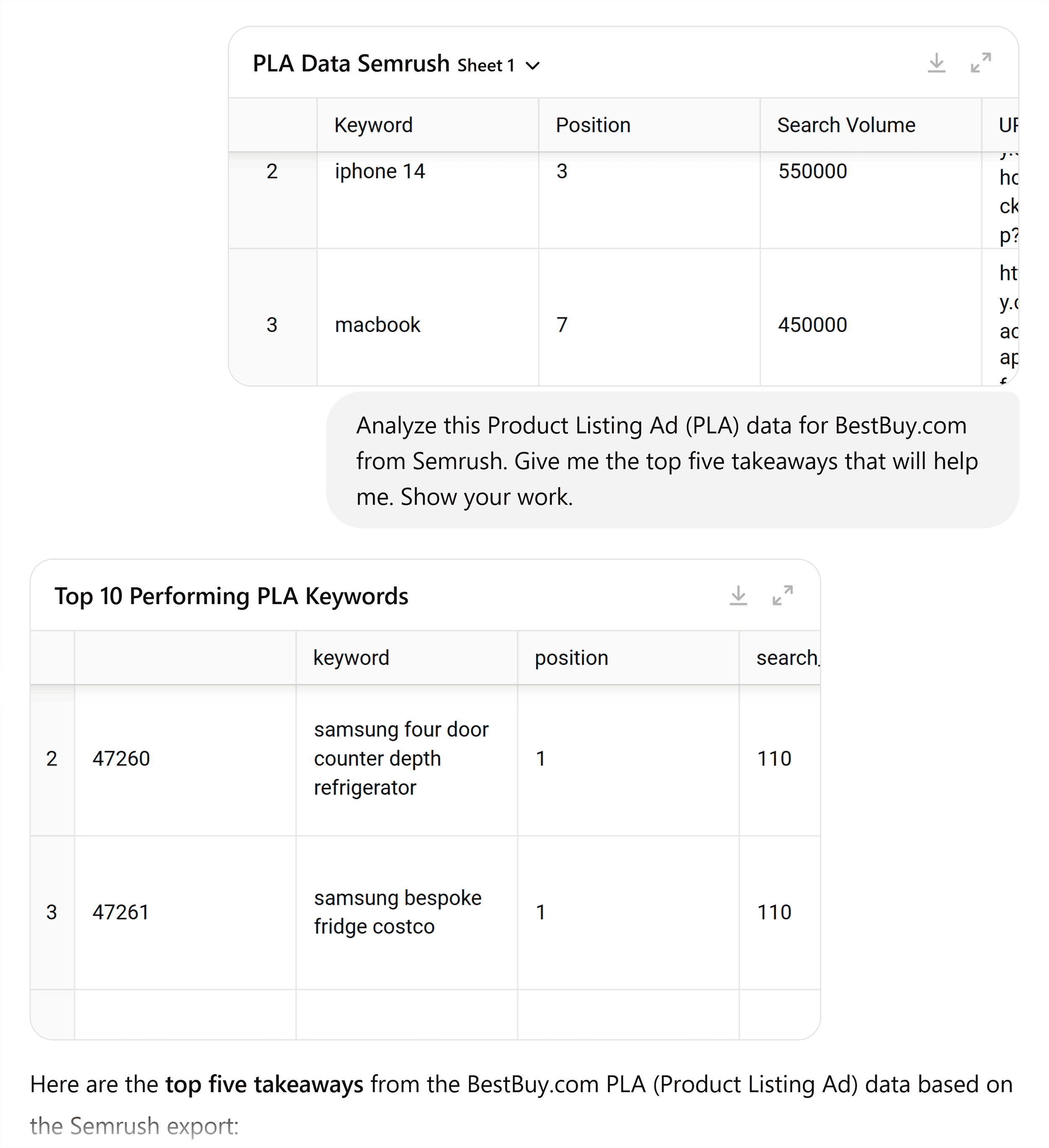
ChatGPT as a Thought Partner
ChatGPT is great for learning and skill development.
For example, you can use it as a conversation partner when learning a new language.
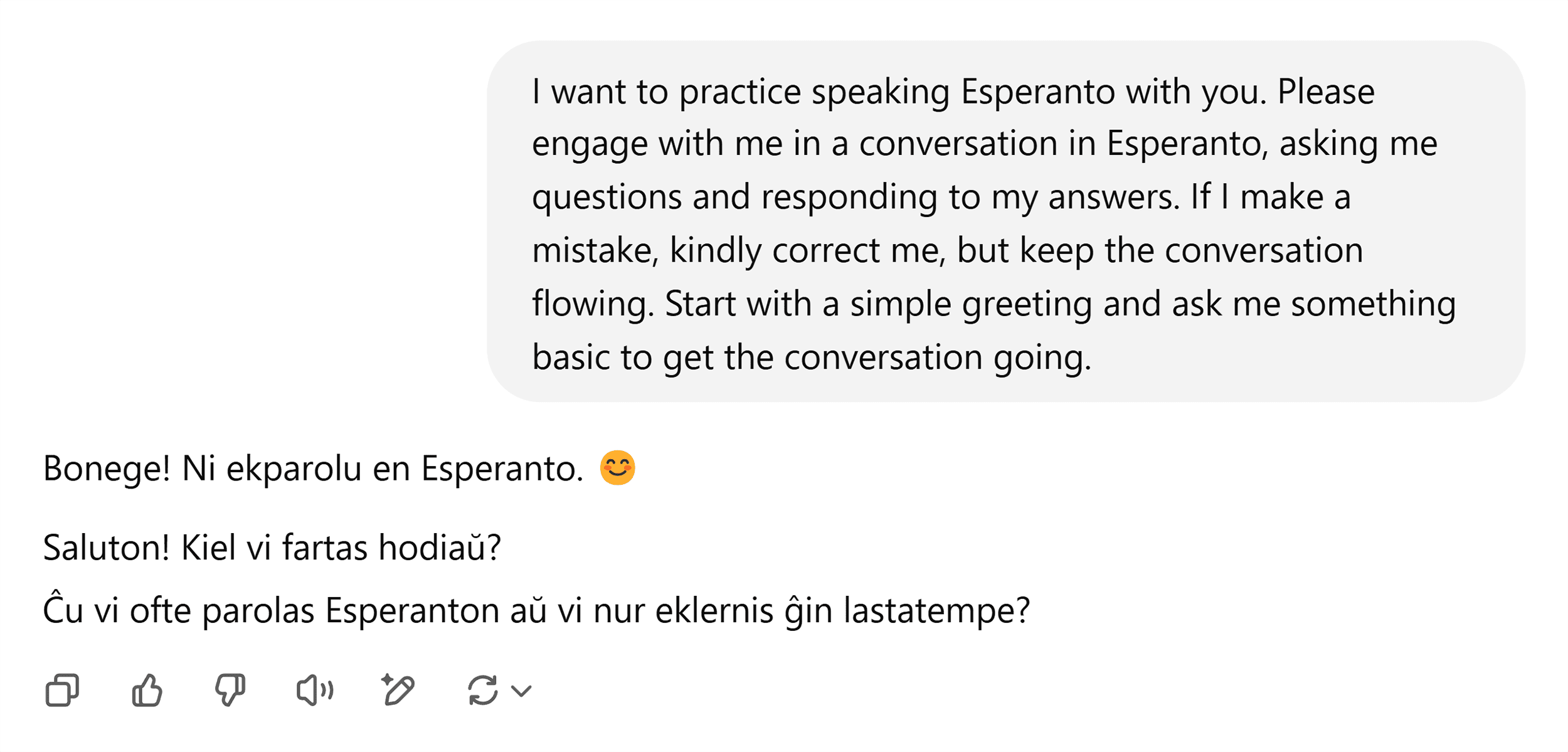
You can also use ChatGPT to stress-test your thinking.
It can challenge your assumptions and poke holes in your reasoning.
I even use it to analyze my content outlines for writing projects.
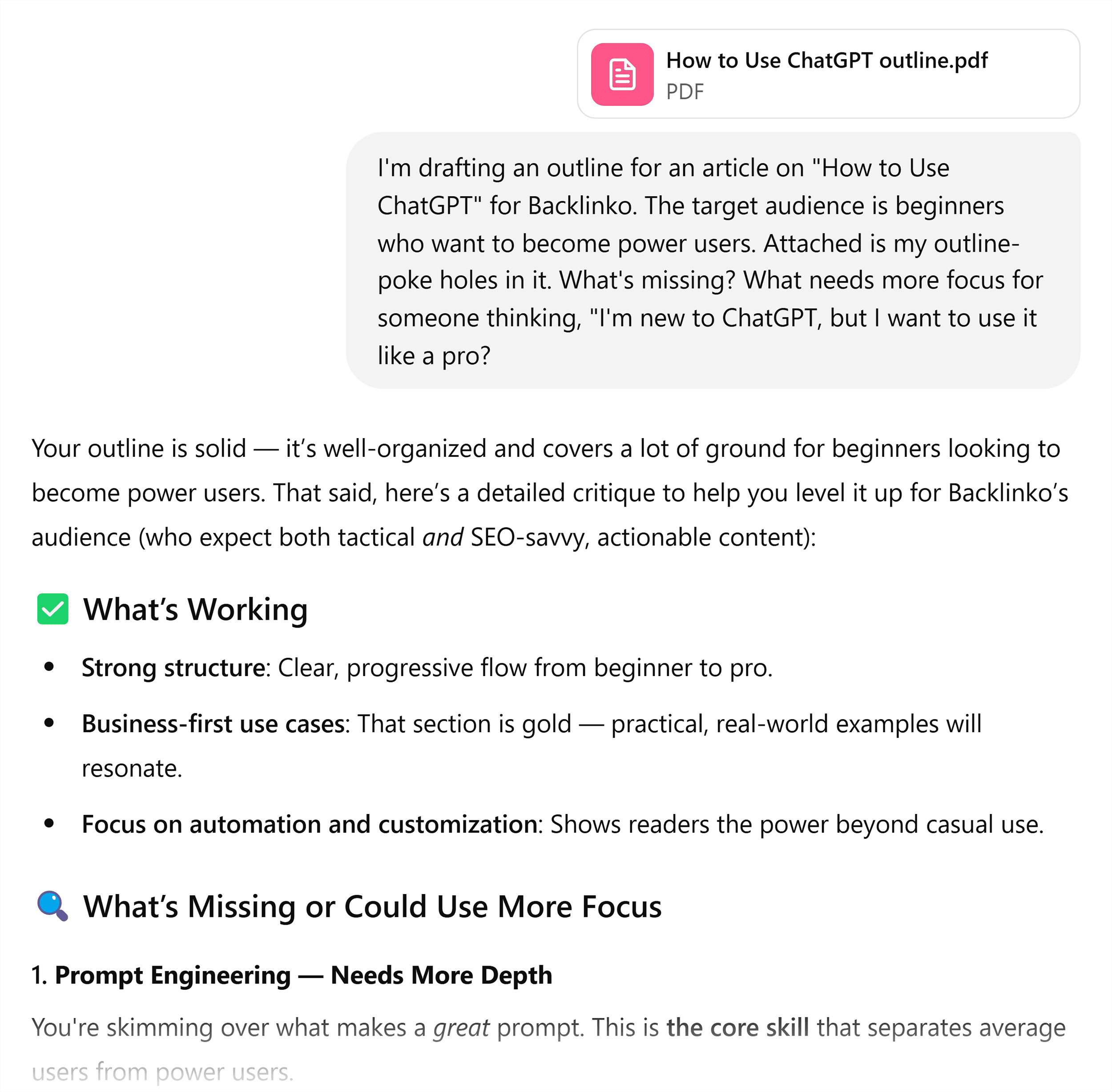
Don’t Stop at ChatGPT. Build Your AI Toolkit.
You’re speaking ChatGPT like a native now.
You’ve gone from curious to confident.
Keep using it, the better you’ll get.
But here’s the thing:
ChatGPT isn’t the only AI tool you should master.
Other generative AI platforms excel at different tasks.
Some crush internet research and exploration. And others are great for chatting with real-life characters.

 BigThink
BigThink 










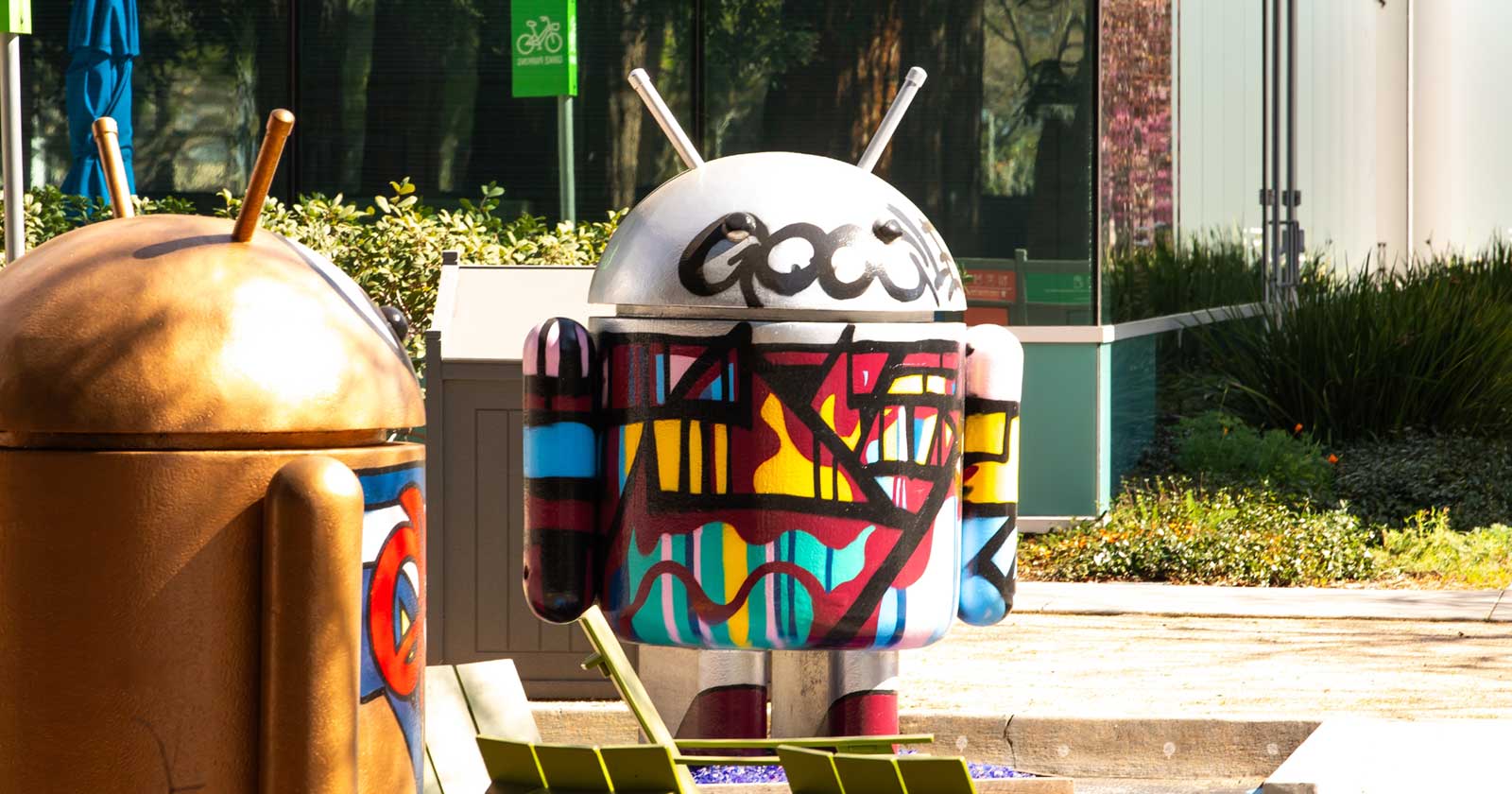








![The 2026 AI Search Benchmark Every SEO Leader Needs [Webinar] via @sejournal, @lorenbaker](https://www.searchenginejournal.com/wp-content/uploads/2025/11/1-259.png)




.jpg&h=630&w=1200&q=100&v=ebcc31501f&c=1)






